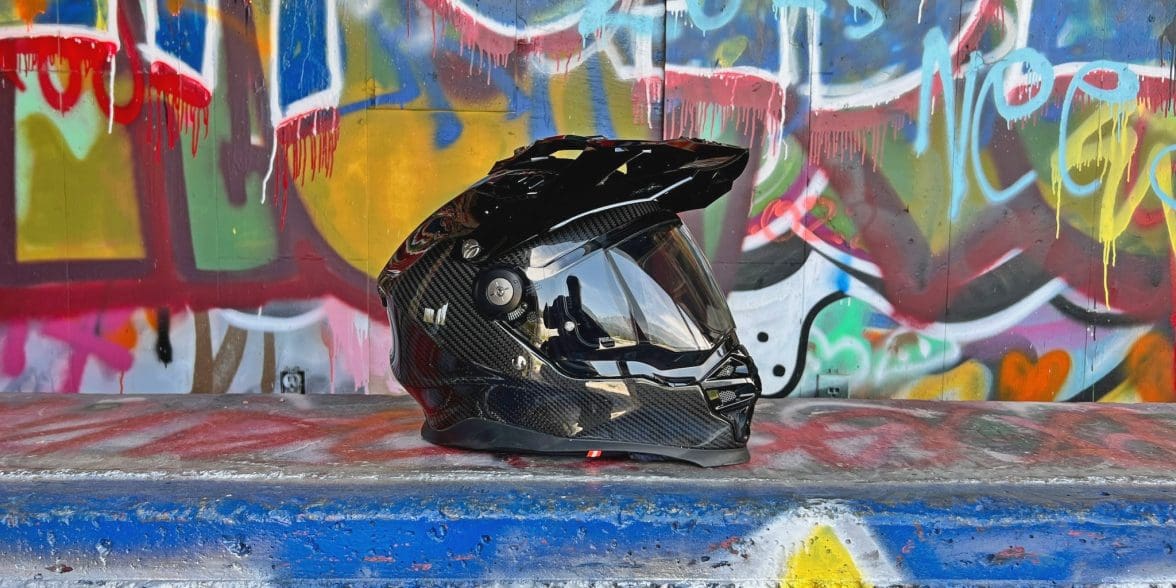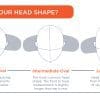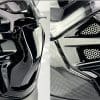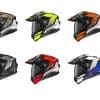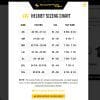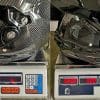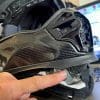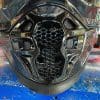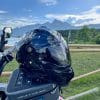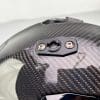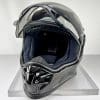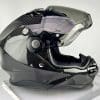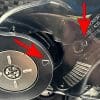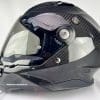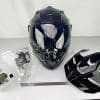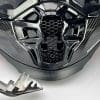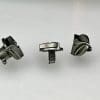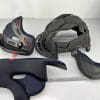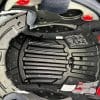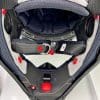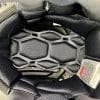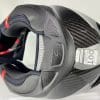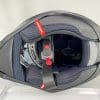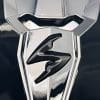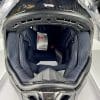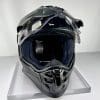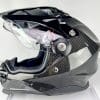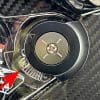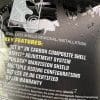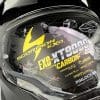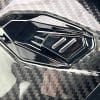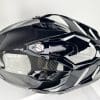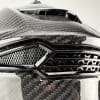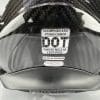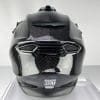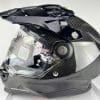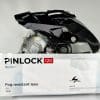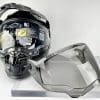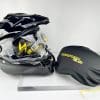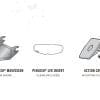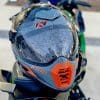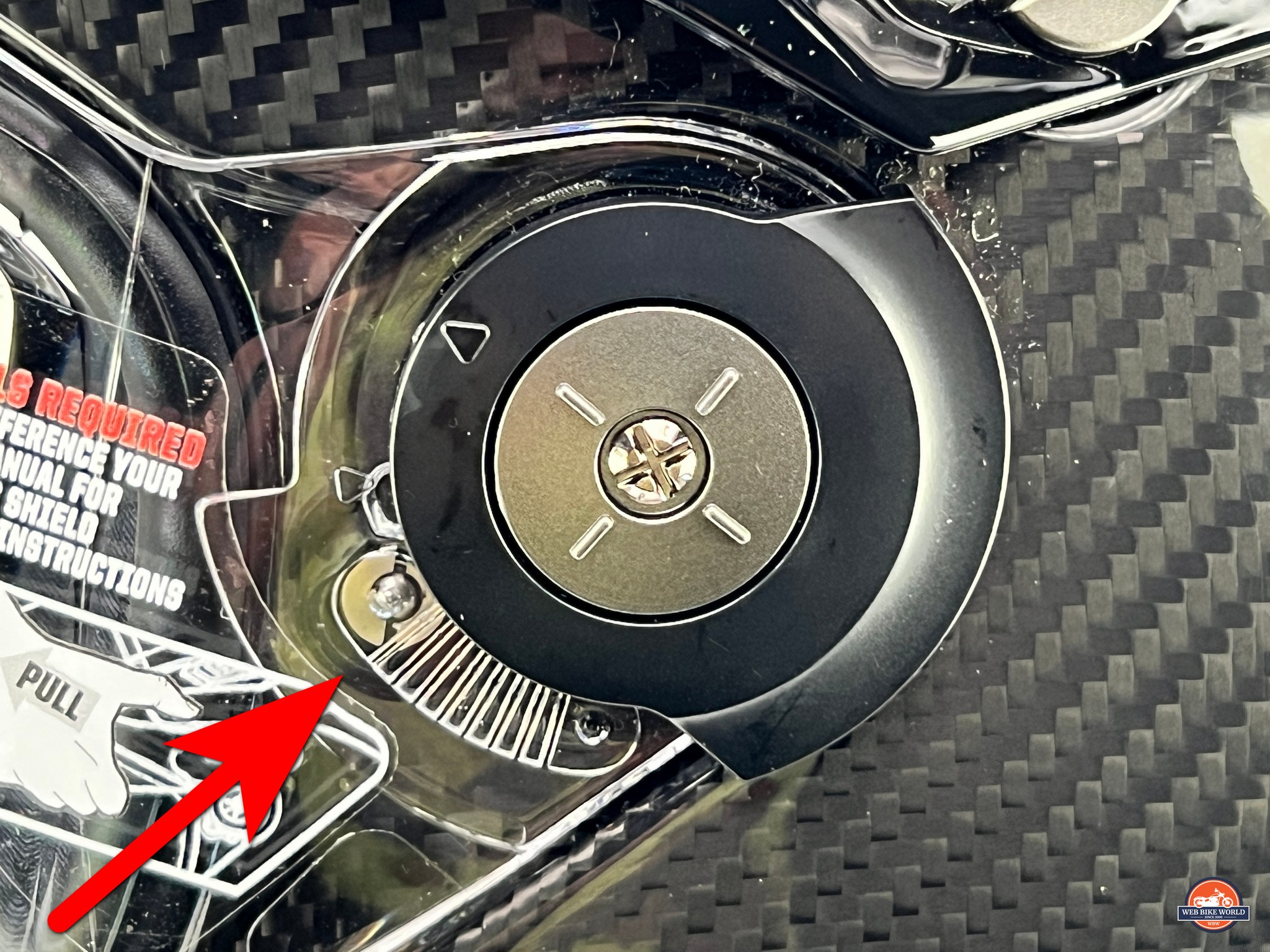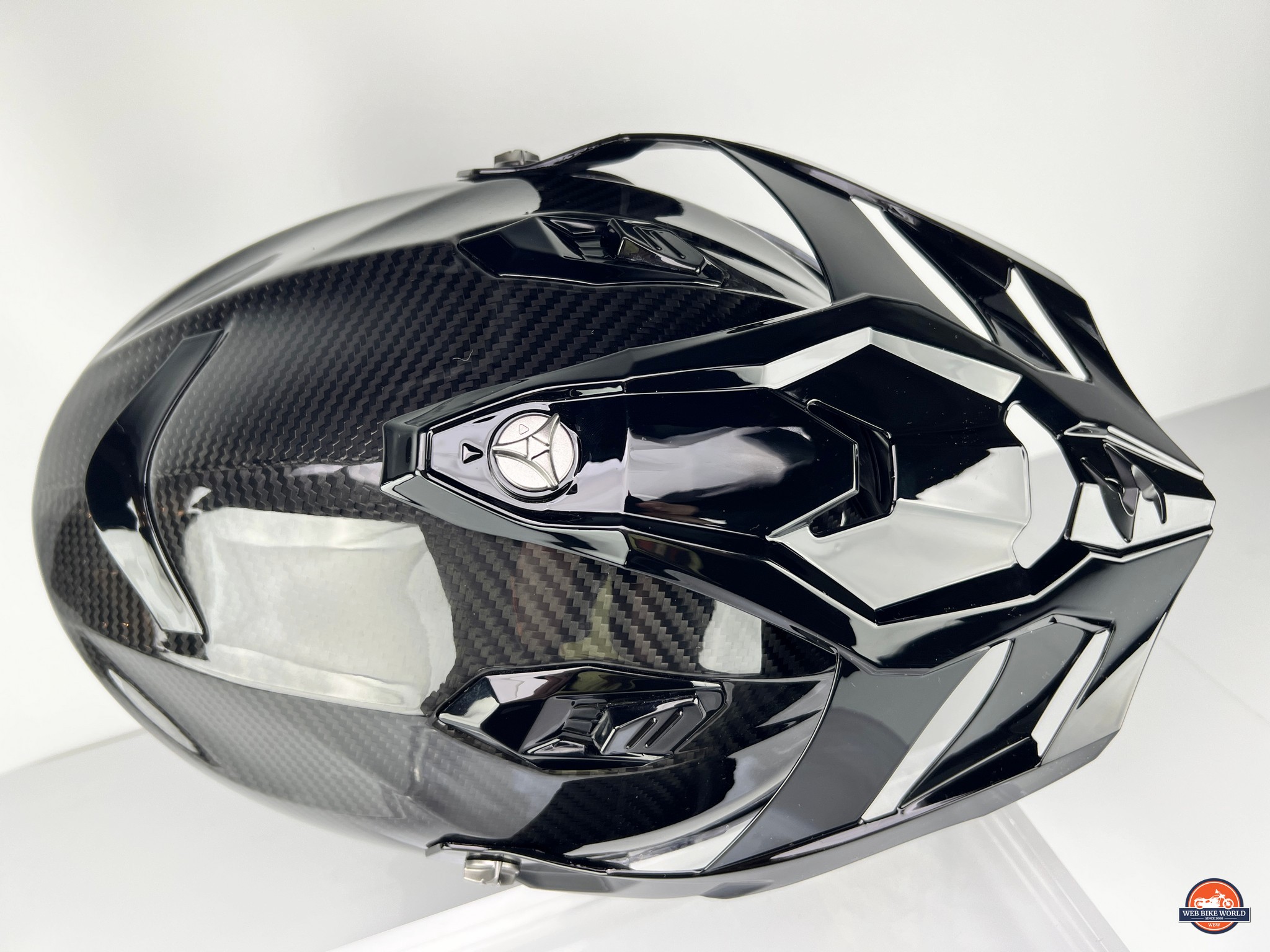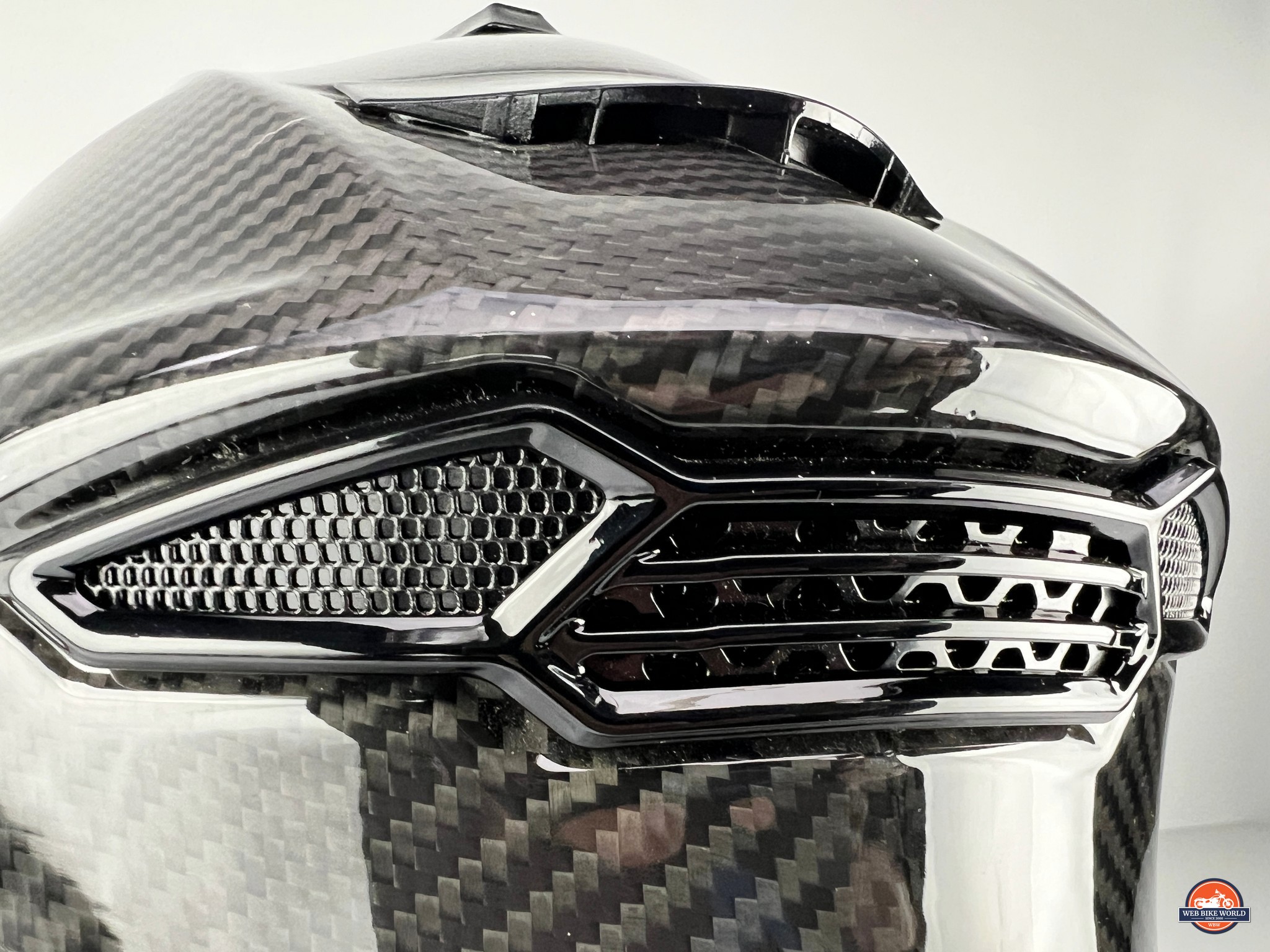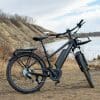Review Summary
- Scorpion has built a helmet that is similar in size, weight, and function to a couple of well-established adventure helmets such as the Klim Krios and Klim Krios Pro.
- The XT’s versatile design also allows the peak to be removed quickly and easily to make the helmet shape more streamlined for on-road-focused riding.
- Despite some fairly large intake vents, the airflow could still be better and may not be enough to keep a rider cool during slow off-road riding.
- The XT9000 is the loudest adventure helmet I’ve worn to date even considering how aerodynamically challenged adv helmets are to begin with. Removing the peak did not reduce the amount of noise.
- The XT9000 represents an impressive baseline measuring stick in the adventure helmet segment. It’s a great product many buyers will adore and with a couple of tweaks, this could be a top-level helmet.
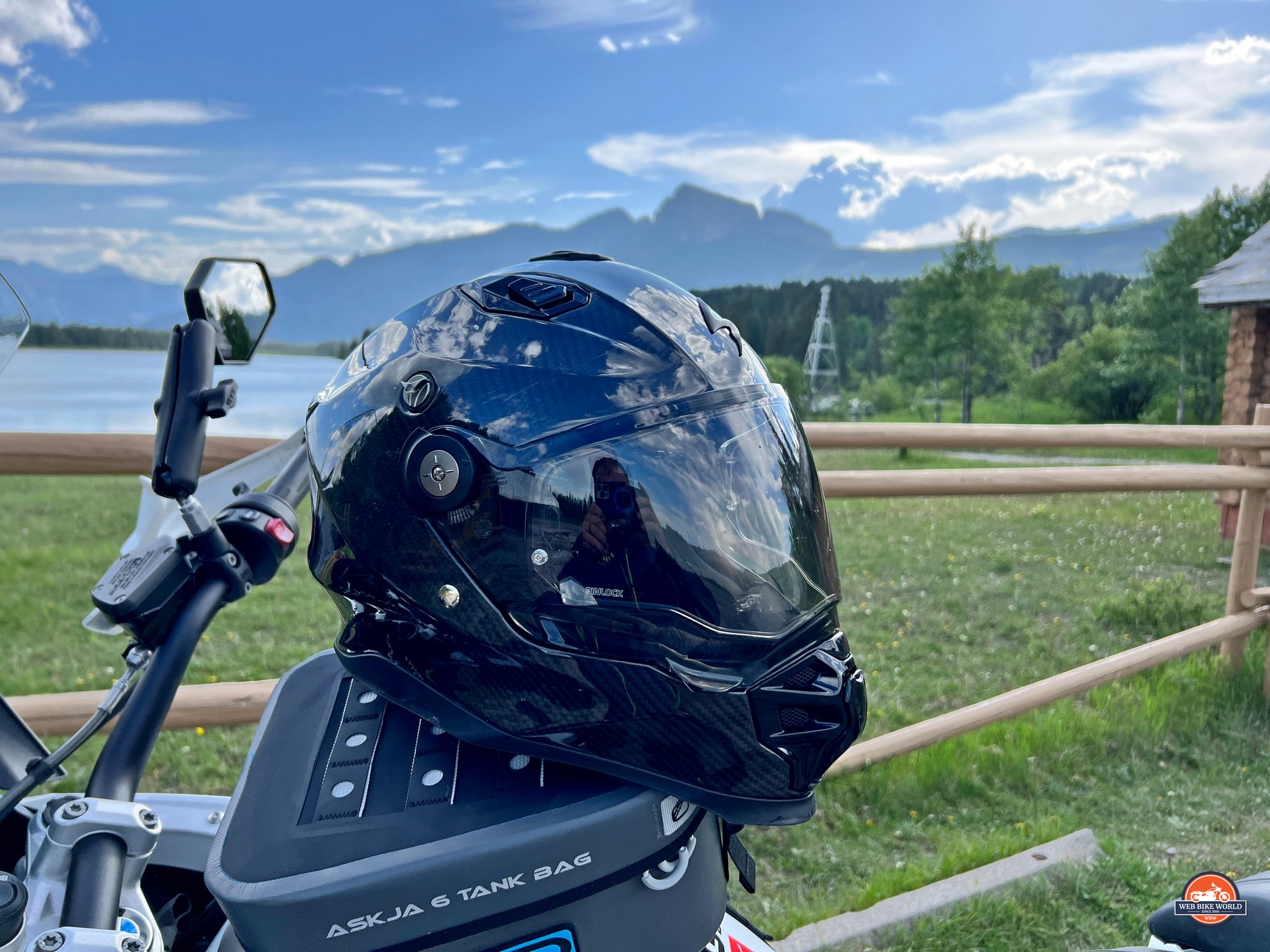
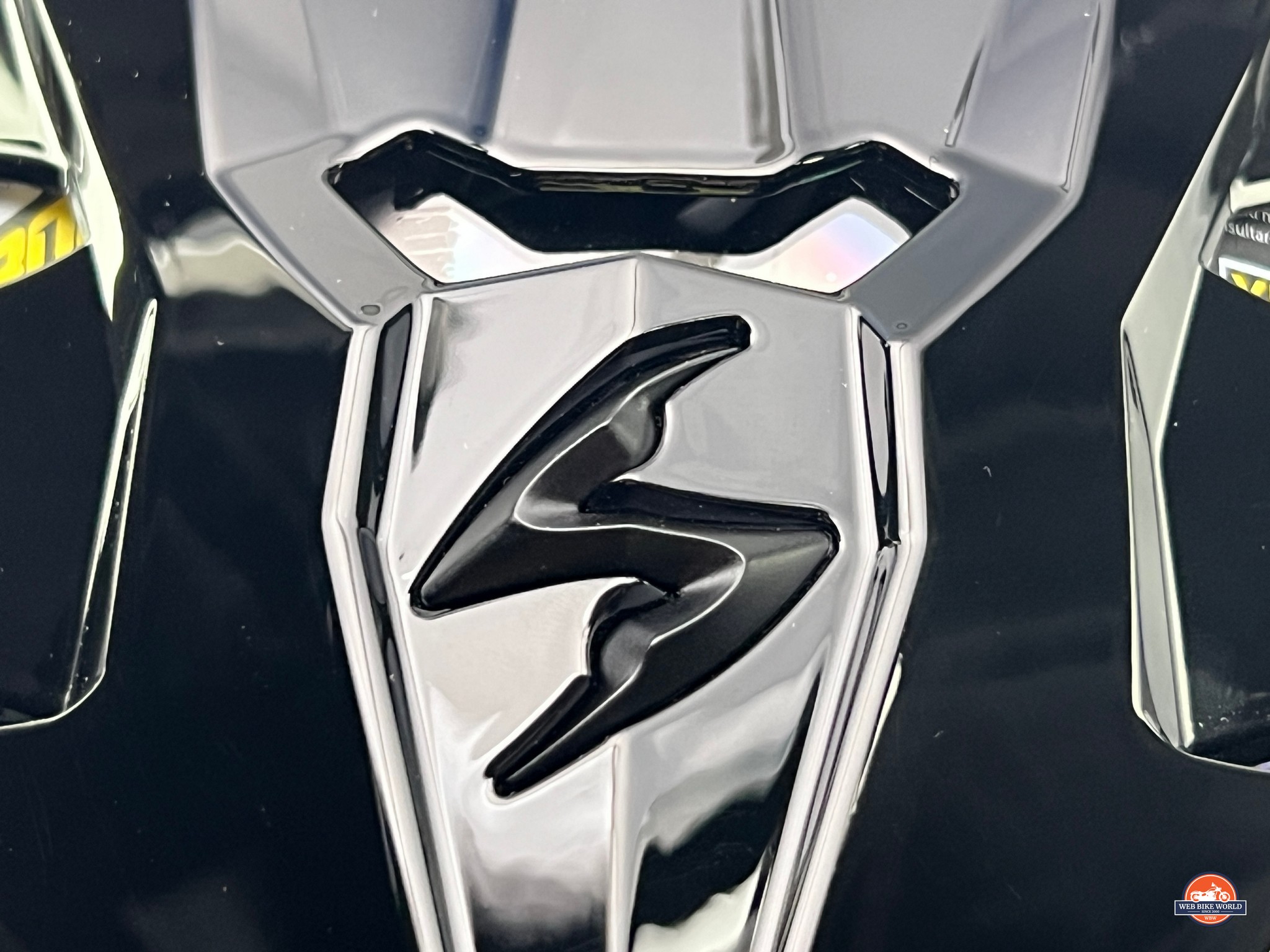
The Scorpion EXO XT9000 Carbon Solid Has Some Swagger
Surprisingly, this is the first Scorpion helmet I’ve ever reviewed for wBW even though the brand is well represented on the site.
Over the last 23 years, Scorpion’s products have scored well with wBW reviewers due to consistently high value per dollar and practical/smart design .
Scorpion’s newest EXO XT9000 Carbon adventure helmet embodies that same shrewd philosophy. For a reasonable price, it has a lot to offer adventure riders.
Securing an XT-9000 Helmet for Review
Scorpion USA provided me with this sample XT9000 Carbon Solid helmet at no cost for the purpose of doing another honest, real-world wBW review. Thank you, Steven!
Let’s go!
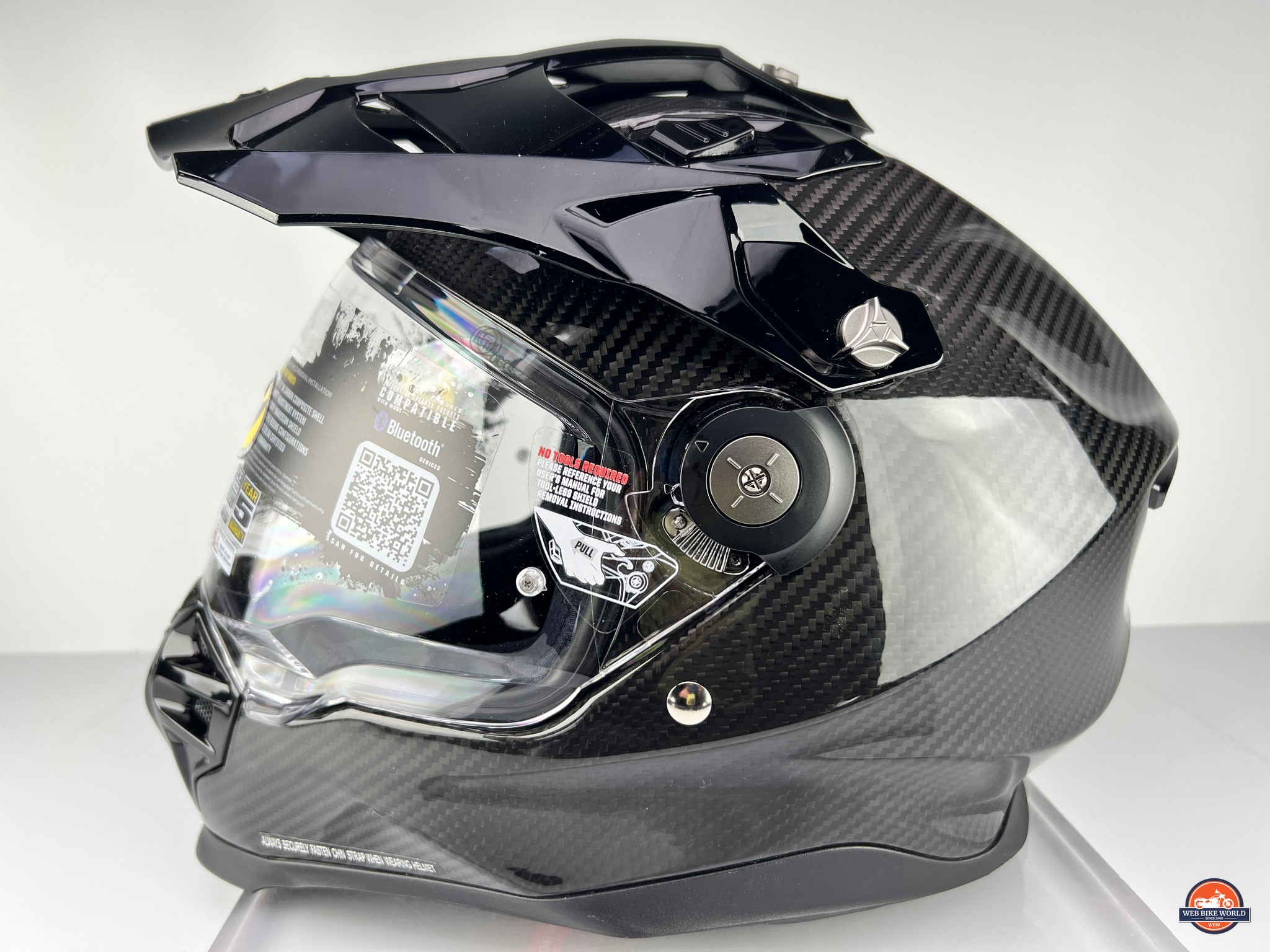
Design, Fitment, & Shape of XT9000 Helmet
The XT9000 aims to accommodate any serious off-road adventure rider’s needs and in my estimation it succeeds at doing that in many ways. For example, allowing the wearer to use motocross-style goggles when riding in really dirty/hot conditions. The XT’s cavernous eyeport is plenty big enough to do that when the main visor lens is removed.
The XT’s versatile design also allows the peak to be removed quickly and easily to make the helmet shape more streamlined for on-road-focused riding.
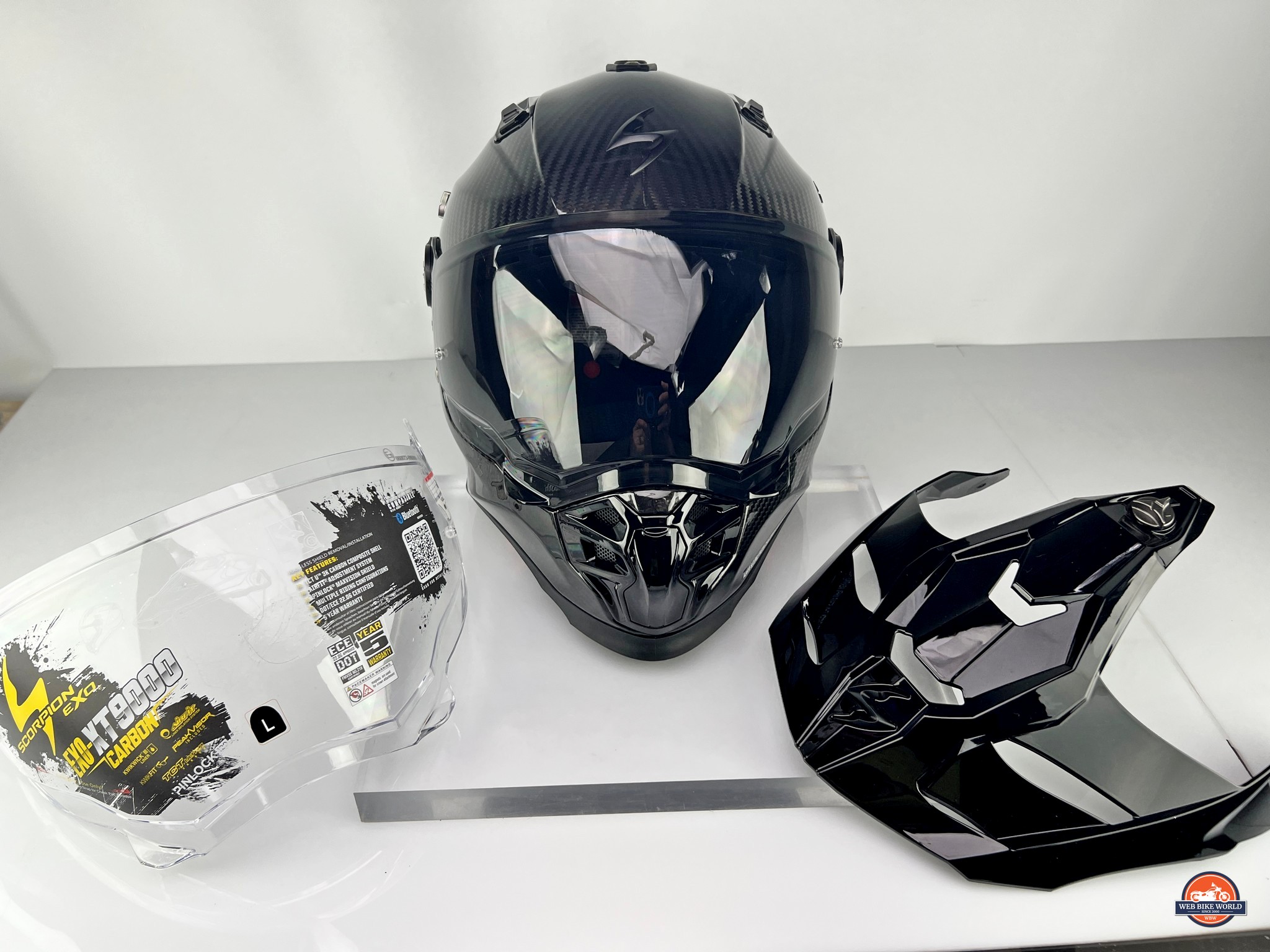
The Removable Sun Peak Fasteners
Three plastic fasteners connect the Peak to the XT9000 shell. The two side fasteners are screw-in types that thread into inserts in the shell while the center one is a half-turn style.
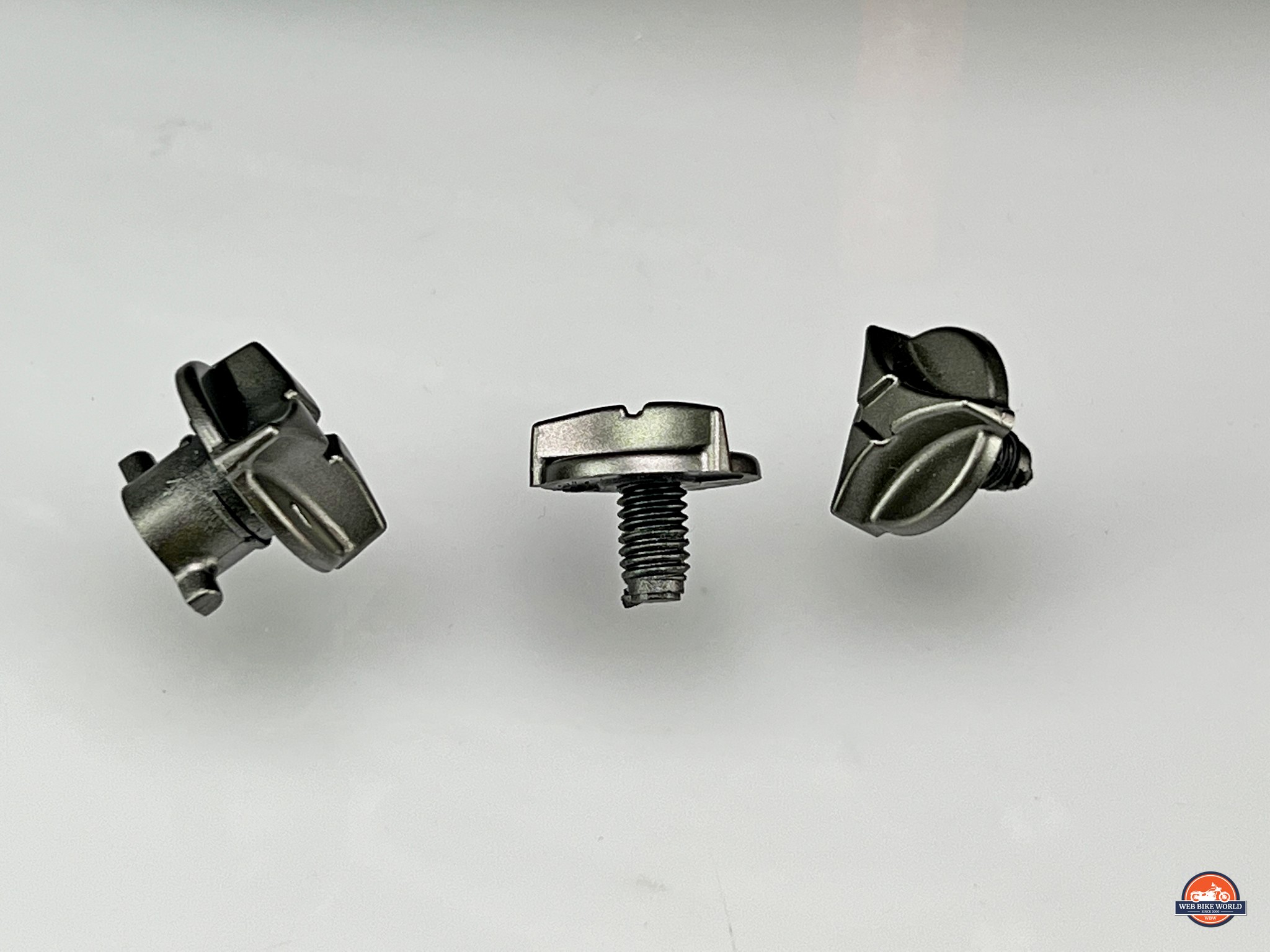
Plastic fasteners are strong enough to hold peaks on adventure helmets but the potential issue with the ones on the XT9000 is the small diameter and quantity. Although I concede none failed during my testing, I think the screws should be twice as large in diameter to better survive a collision with a passing tree branch, flying gravel, or clods of mud.
The plastic screws on the Arai XD-4 are twice as large in diameter and there are two on each side to hold the peak on in case one breaks or vibrates out.
At least replacement screws are inexpensive on the XT9000. A second set of 3 will only set you back $15 US, and I would recommend carrying replacements for this helmet just in case.
What’s In The Box?
The XT9000 comes with a greater supporting cast than most helmets do. See below.

The box has two top-quality visors along with a Pinlock 120 insert which is enough to thrill any helmet-buying motorcyclist.
As a bonus, there’s a chin skirt and action cam mount. For some reason my sample XT9000 didn’t arrive with the camera mount included, but since I don’t use GoPro devices for my video work anyway, I wasn’t too disappointed.
The Safety Factor
Since job one for this safety hat is protecting the rider’s head in a crash I’ll praise Scorpion for making the XT9000 compliant with the new ECE 22-06 guidelines in addition to the longstanding DOT FMVSS 218 standards.
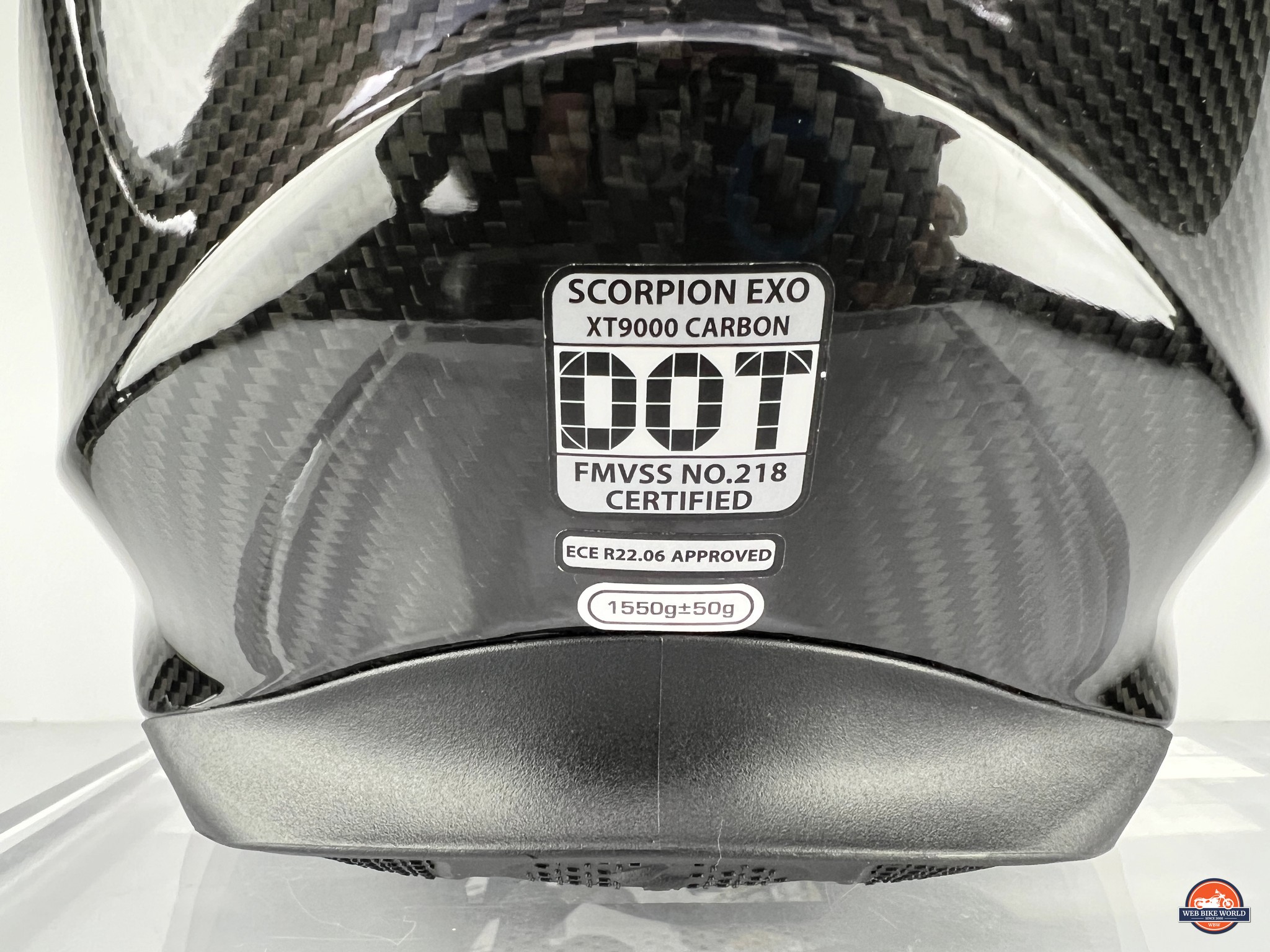
Dual certification isn’t mandatory in North America for motorcycle helmets, but I wish it was since having more than one group of experts putting their stamp of approval on a helmet makes me feel more confident about wearing it.
The ECE 22-06 standard offers added value (versus the former 22-05) by ensuring a helmet offers a measurable degree of protection from extra deadly rotational forces in a collision. DOT doesn’t include this criterion at all.
SHARP Testing
SHARP is an independent testing organization based in the UK that I like to reference in my helmet reviews whenever possible. Unfortunately, the XT9000 hasn’t been tested by them yet so I can’t provide any additional information on its crashworthiness.
None of Scorpion’s helmets have scored a perfect 5/5 stars from SHARP as you can see by visiting the SHARP site. Typically though, Scorpion helmets earn a respectable 3 or 4 stars.
Maybe the XT9000 will be the one to finally land a 5/5?
Fitment
My 23” circumference (58.42cm), Round-Oval-shaped head often makes choosing the correct helmet size a coin toss. Sizing charts usually place me right between a Medium and a Large, and this time initially looked to be no different.

Steven sent me the size Large XT9000 and I noticed the tag on the inside of the helmet says it fits heads ranging from 58cm to 59cm. That’s a different split than what’s shown on the chart from the Scorpion website (below).
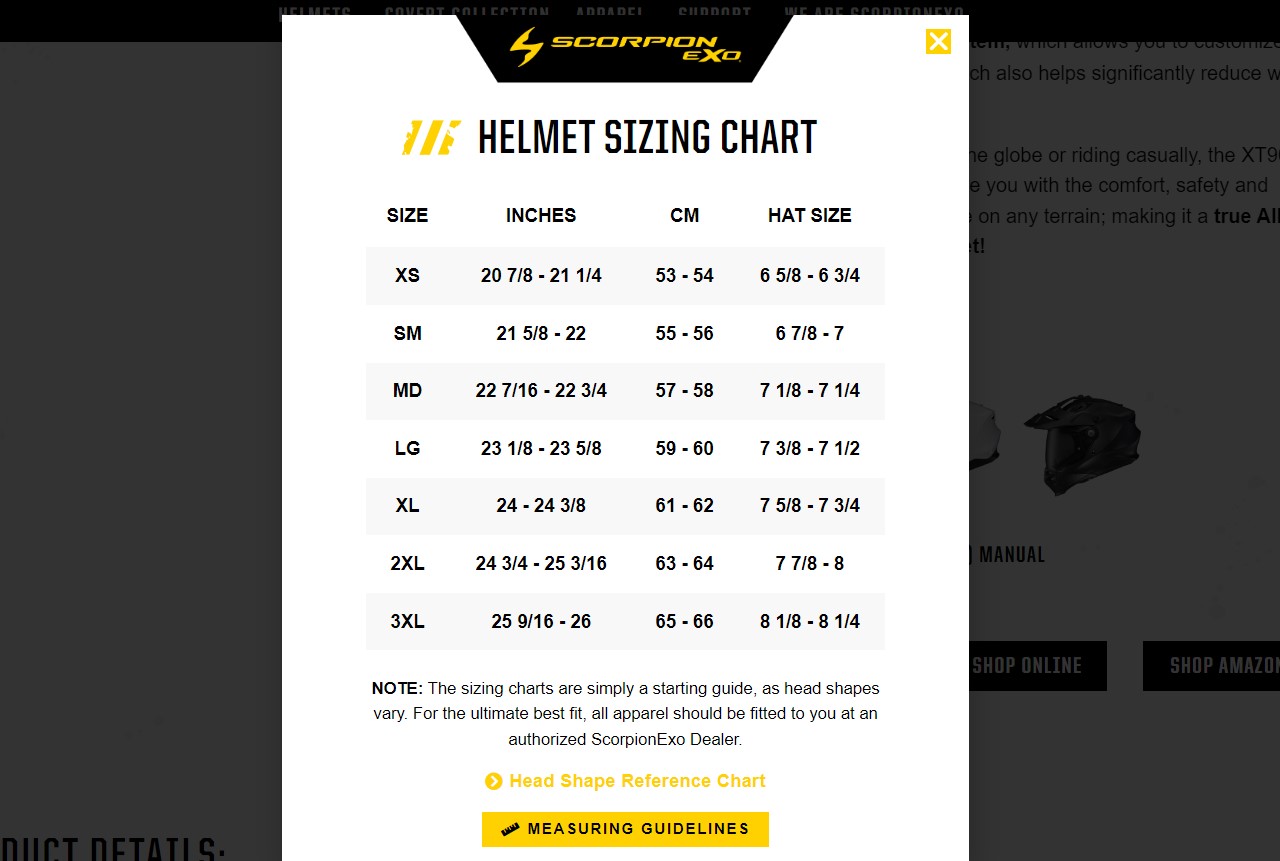
Large was the right fit for my head as it turns out but I’d recommend a “try before you buy” approach or size up if your head lands on the upper end of the range.
Intermediate Oval Fit
The shape of the XT9000 fits me like an Intermediate Oval because both sides of my slightly wider head sit very snugly near the temple areas while touching the rest of the interior comfort liner quite evenly.
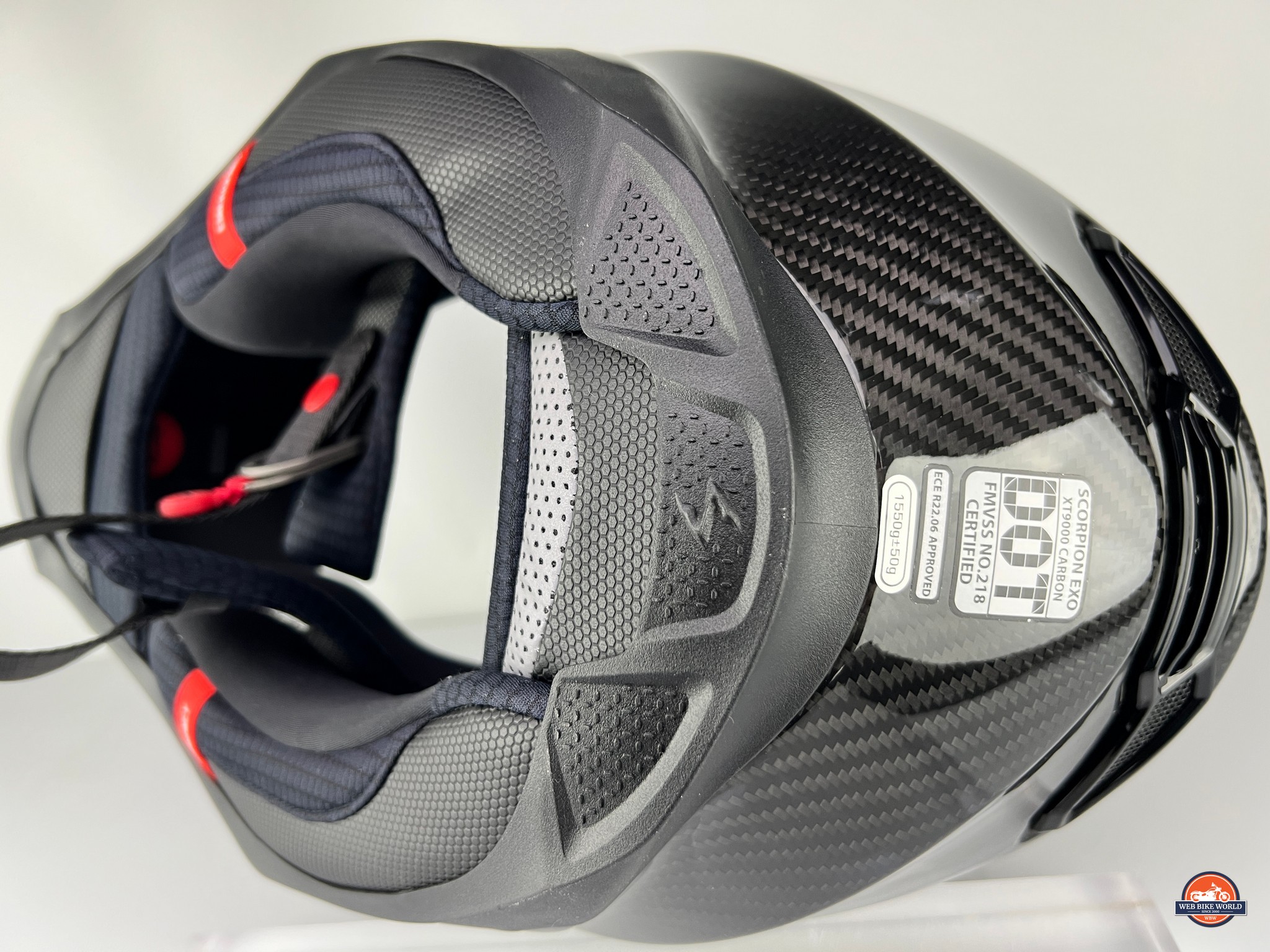
3 Shell Sizes
Pulling this helmet onto my head isn’t a painful, ear-folding ordeal as with some others I’ve tested, and there are nice sized pockets for ears on each side that don’t rub or irritate my listeners.
This is probably thanks to the three shell sizes used to ensure the XT9000 shells stay proportionally closer in size to the wearer’s head. Not too small and not too big is the end goal in having more than two shells to work with and I give credit to Scorpion for making the effort.
And Yet… The XT Feels Big On Me
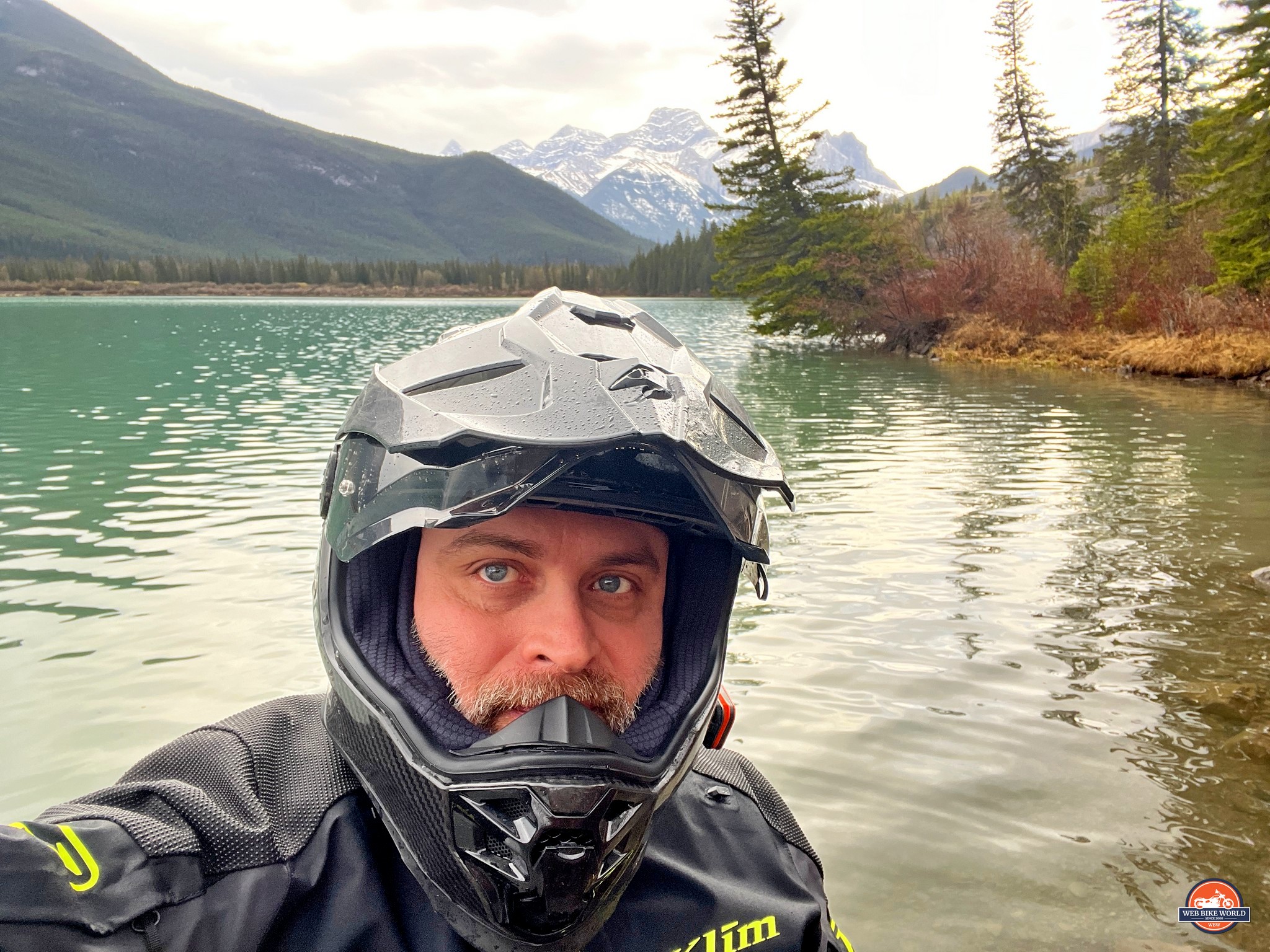
Despite their efforts, when I wear the XT it feels bulkier and larger than the other adventure helmets I’ve worn before. Physically the XT isn’t significantly larger when compared to my Krios Pro, Arai XD-4, or Shoei Hornet X2 so I’m betting that the center of mass is higher up in the XT shell than in those other admittedly much more expensive helmets. We’re talking twice as expensive!
The Airfit® liner inflation system
Remember the Reebok Pump running shoes that had inflatable air chambers to help get a better fit? Scorpion has a similar system in the XT9000 to help pump you up.
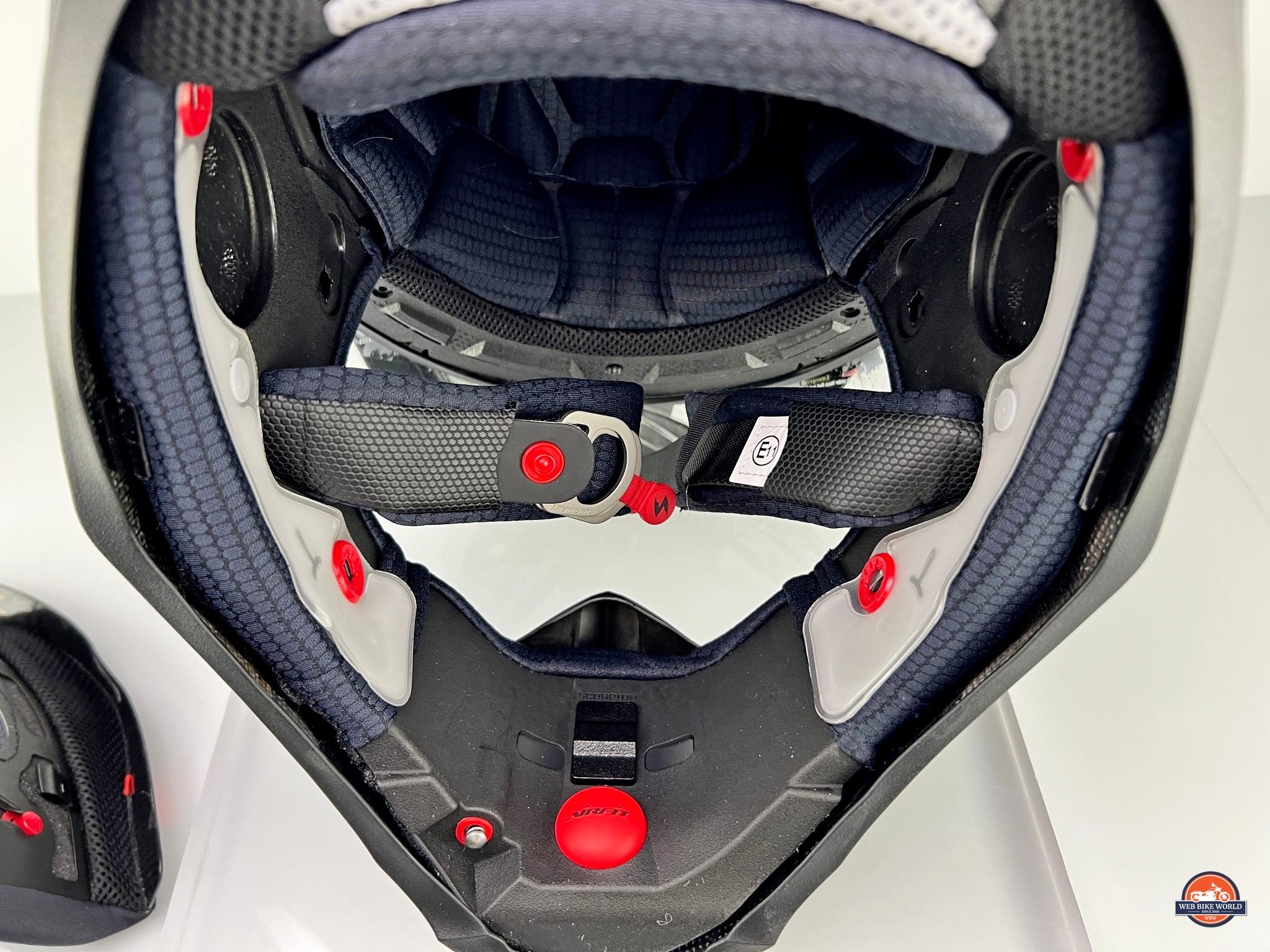
In the photo above you can see a red rubber bulb that the wearer pushes repeatedly to send air into two white-colored air bladders located on each side of the chinbar. The small silver button with the red ring around it on the left side is the air drain valve.
Despite experimenting with this seemingly novel feature I never fell in love with it, probably because my head is wide enough already to fit snug against the cheek pads in the XT, but other wearers may find value in it.
I would trade this unnecessary-to-me Airfit system for a lighter overall weight and better chin bar airflow in this helmet by removing it from the XT9000 design… I’ll explain this more later.
Interior Comfort Liner
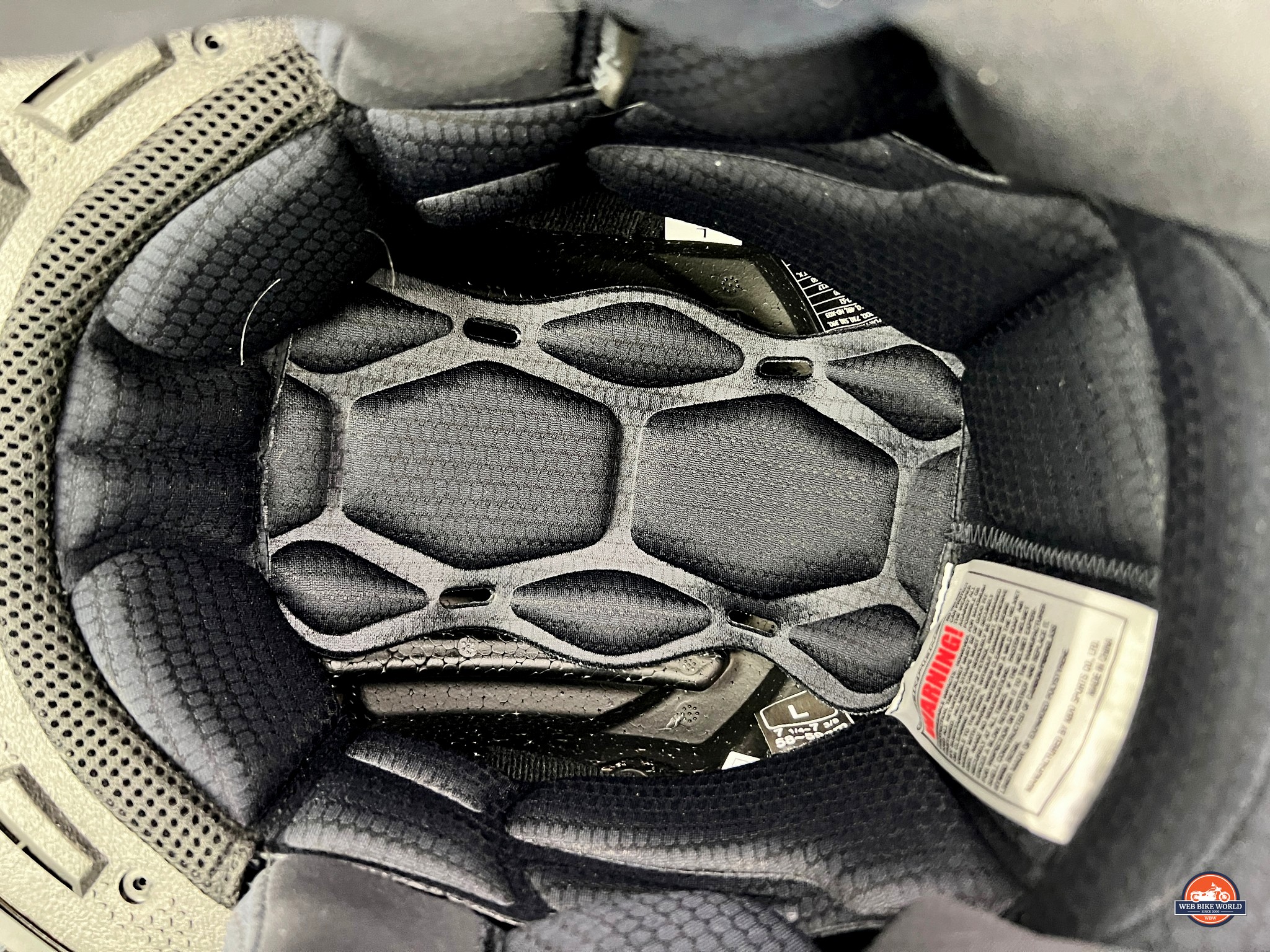
The interior of the XT is silky smooth nylon with a honeycomb pattern built into the material. It effectively pulls sweat away from my face as advertised and is washable, antimicrobial, and easy to remove/install as expected of any quality helmet these days.
Good job Scorpion! This is the right way to build a high quality comfort liner.
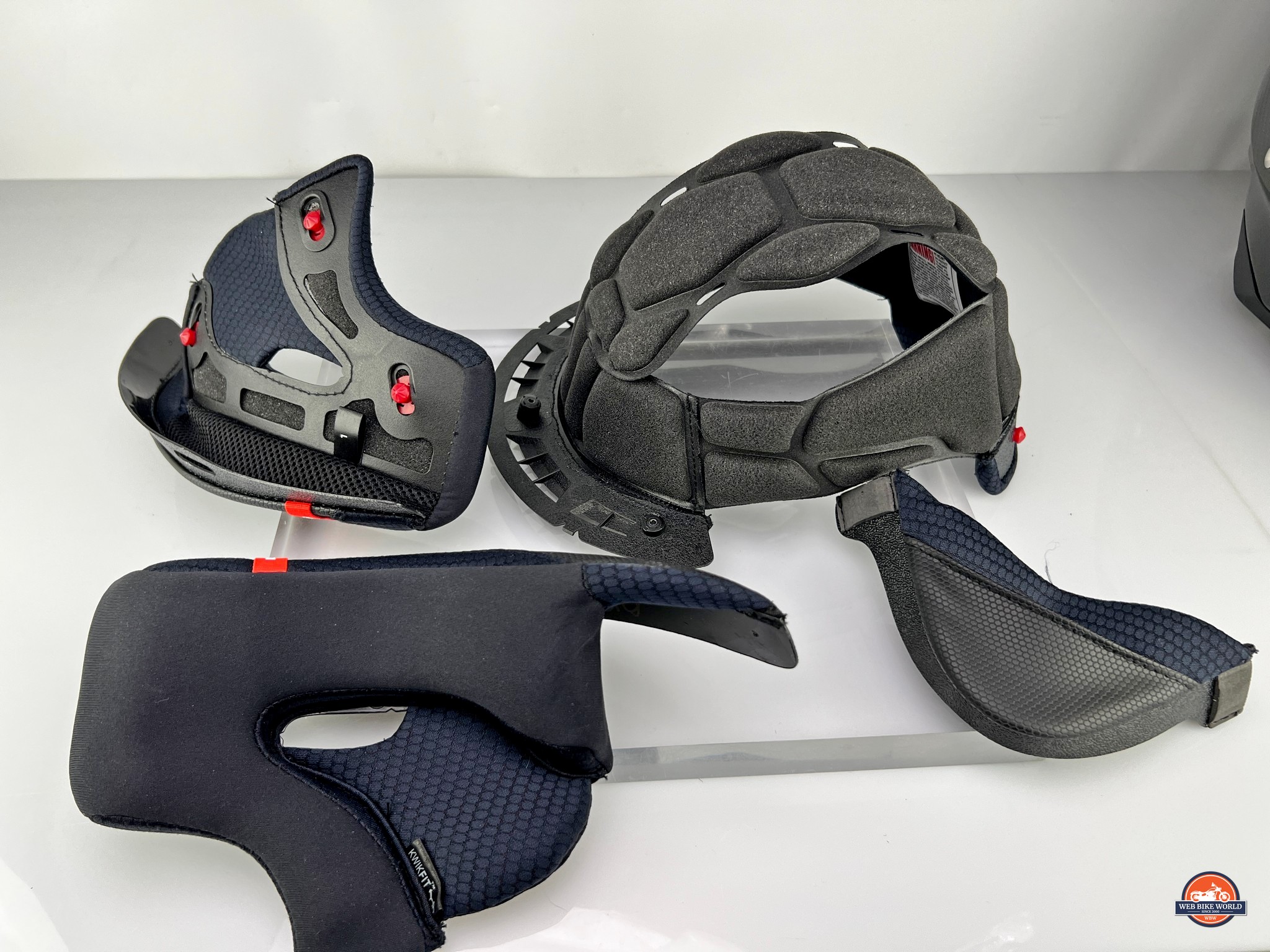
The only thing I would change about it is to have multiple layers of thin foam built in that are removable from different parts of the liner in order to facilitate adjusting the fit for different head shapes.
Weight
My size Large XT9000 has a label on the back claiming it weighs 1550g +/- 50g or 3.52lbs which is in the ballpark of what my scale says it actually weighs.
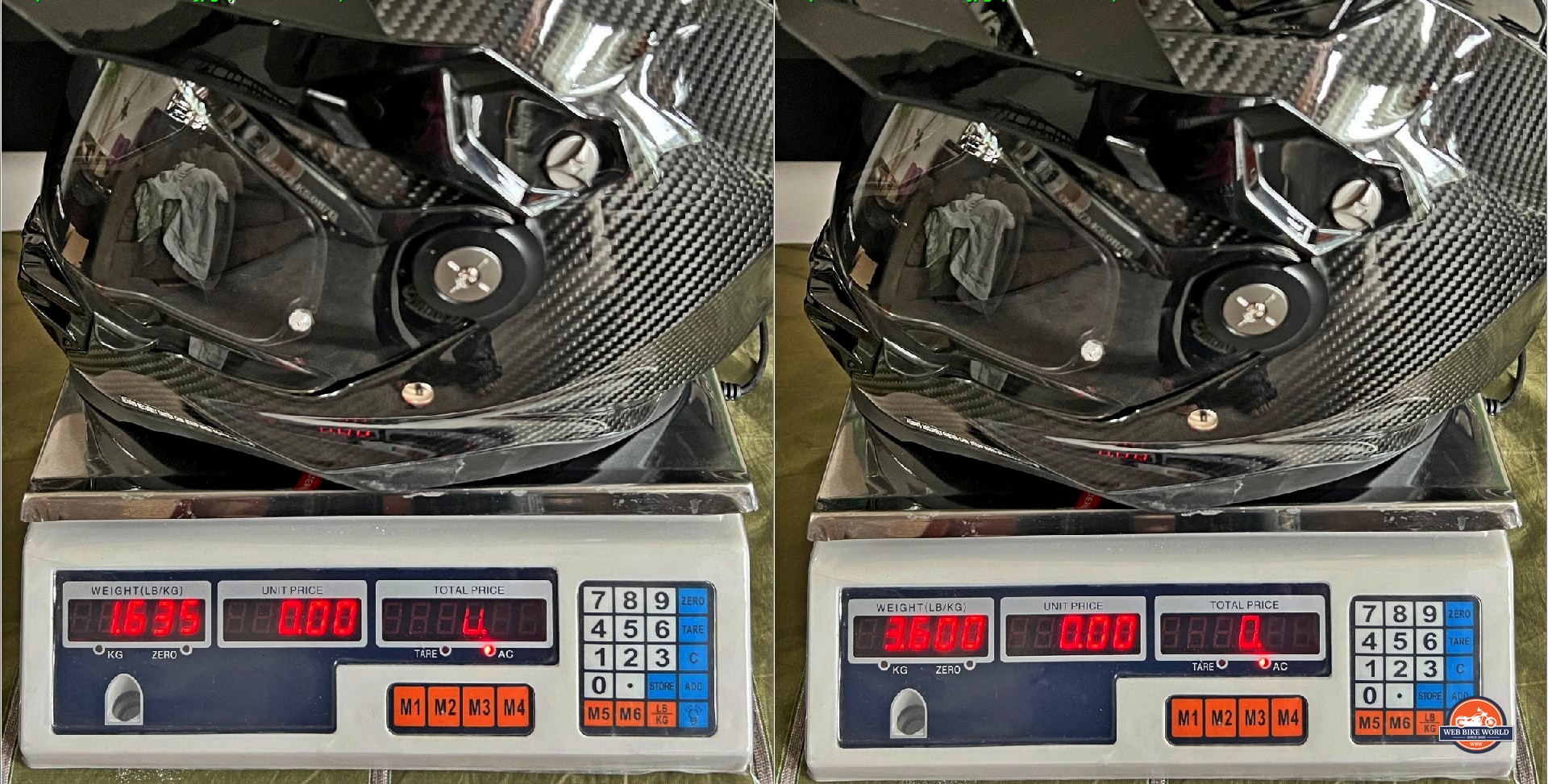
Chinstrap Latch
Scorpion equipped the XT9000 chinstrap with double D ring loops made out of titanium along with a snap closure used to secure any excess strap length.
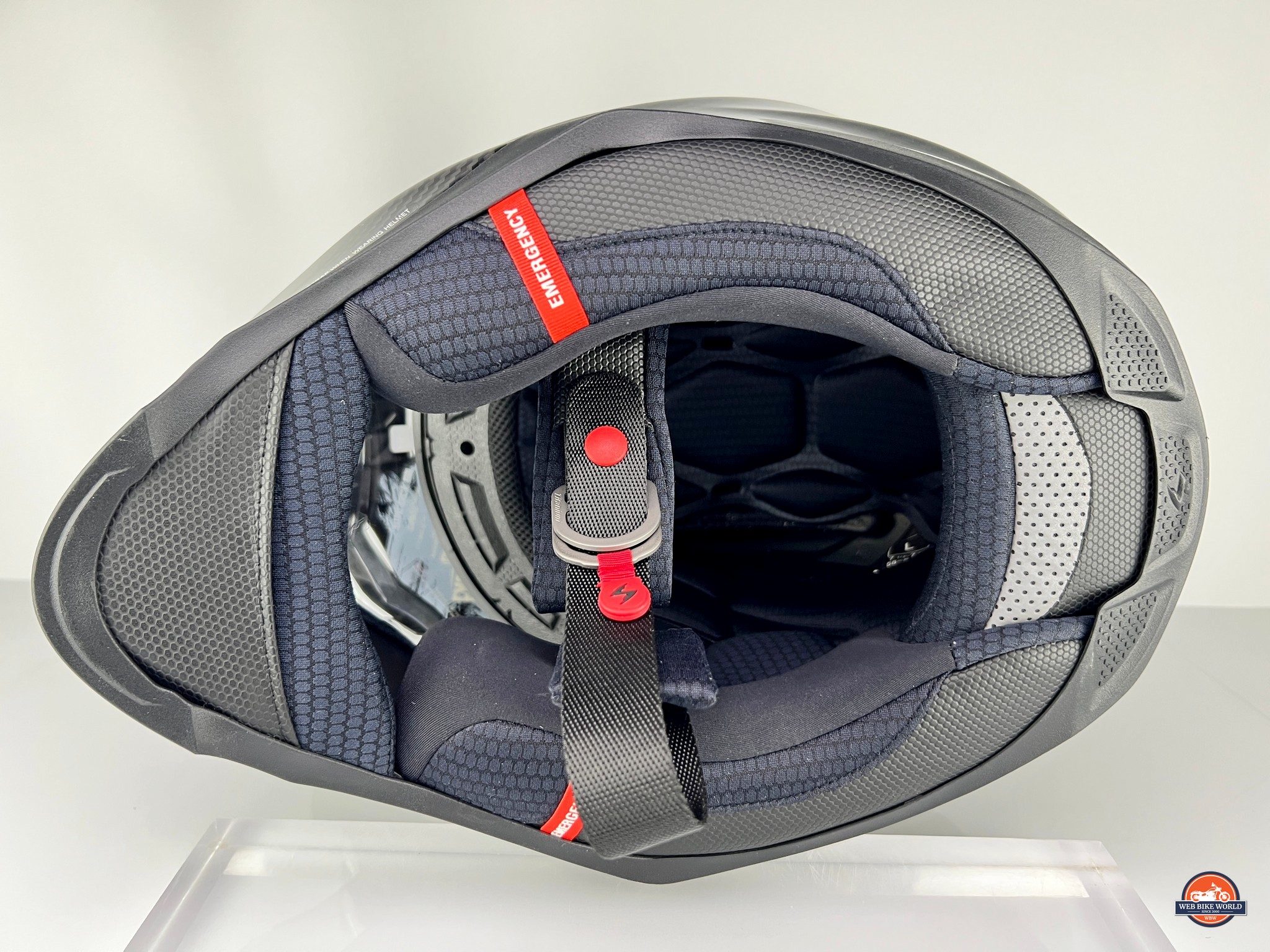
That snap is located so far up on the left strap that it all but disappears inside the cheek pad when cinched under my chin and I find it near impossible to use with my gloved fingers. I’m noticing this same problem on all the ECE 22-06 approved helmets I’ve reviewed lately and think the new standard’s chinstrap specifications might be the root cause of this inconvenient location.
Scorpion XT9000 Visor & Field of View
More than any other feature on the XT9000 the visor and eyeport designs get a standing ovation from me. Scorpion really nailed this design aspect of the helmet.
The Eyeport Design
The XT9000’s eyeport is the Grand Canyon of helmet eyeports! Its mouth is so massively broad that I feel like I’m wearing an open-face helmet! Only the breath deflector is in my lower field of view and there’s no issue for me when I look down to retrieve items like my wallet from the pockets of my riding pants or jacket.
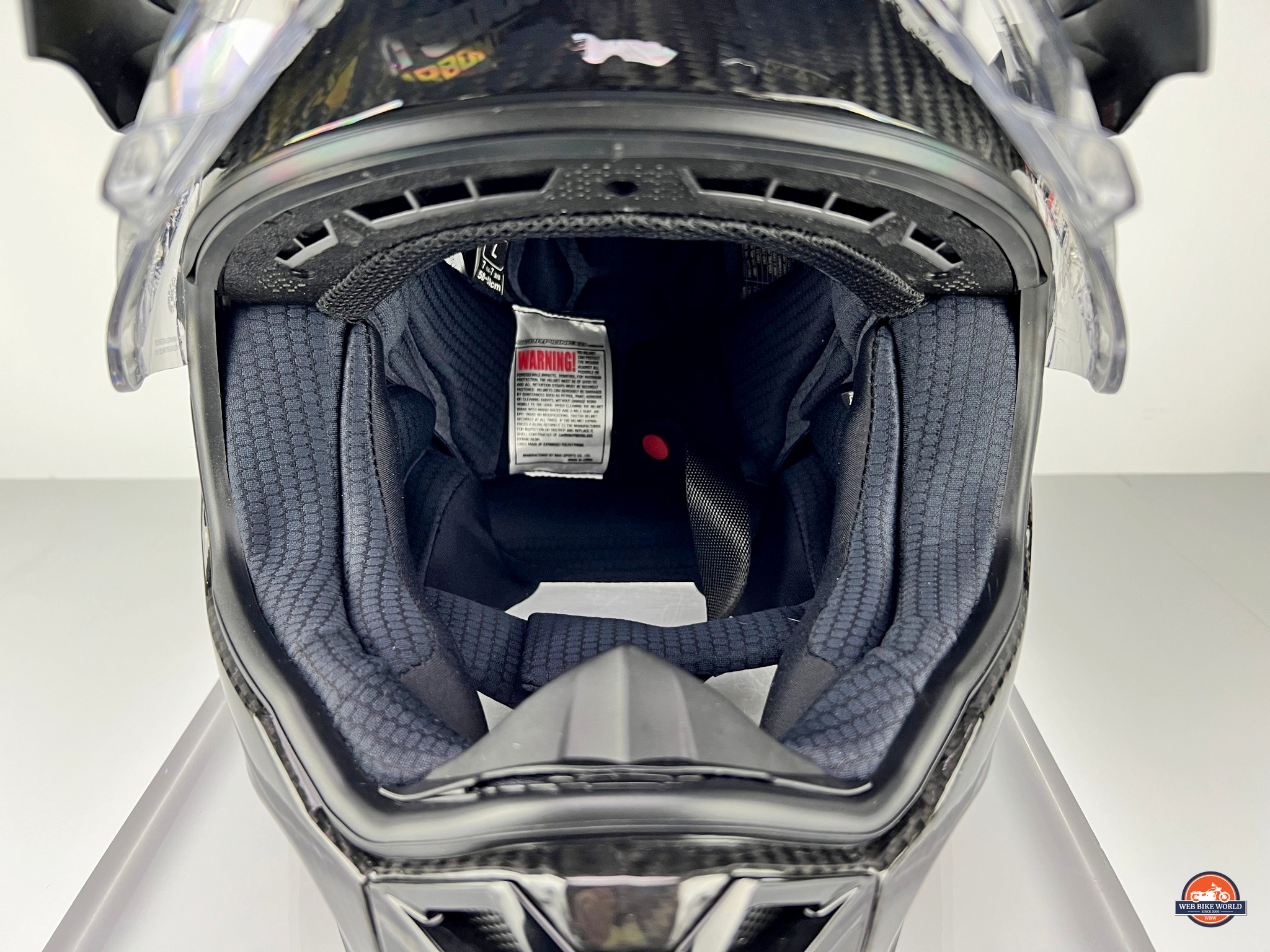
Honestly, it seems almost too large to offer enough protection from incoming flying debris or roost off the tire of other motorcycles in front of me.
The Visor
What makes the XT visor so good? Well, there are several traits that an admitted “visor snob” like me insists on having that the XT hits on.
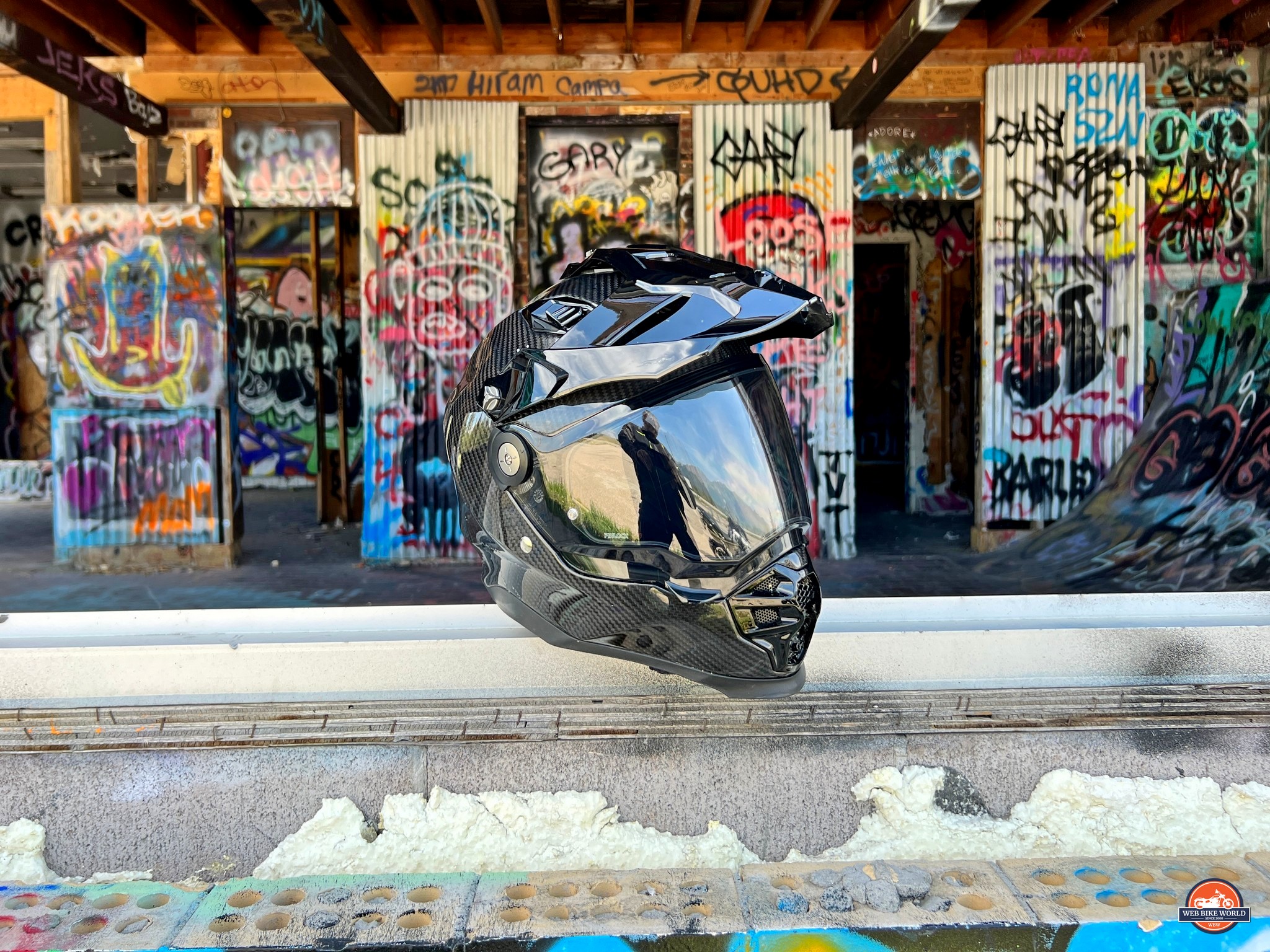
The visor clarity, scratch resistance, Pinlock positioning, and mechanical action/detent performance are all as good or better than anything out there I’ve tested. Especially good is how the Pinlock lens fits so perfectly in the visor that I never notice the seam or edge of this anti-fogging lens when looking through the visor.
In comparison, the Klim Krios Pro visor has a terribly undersized Pinlock in its visor. The top edge of the Pinlock in the Klim is always frustratingly in my field of view. How could Klim get this design aspect so wrong on their $750 US helmet while Scorpion hit the bullseye perfectly with their $500 lid?
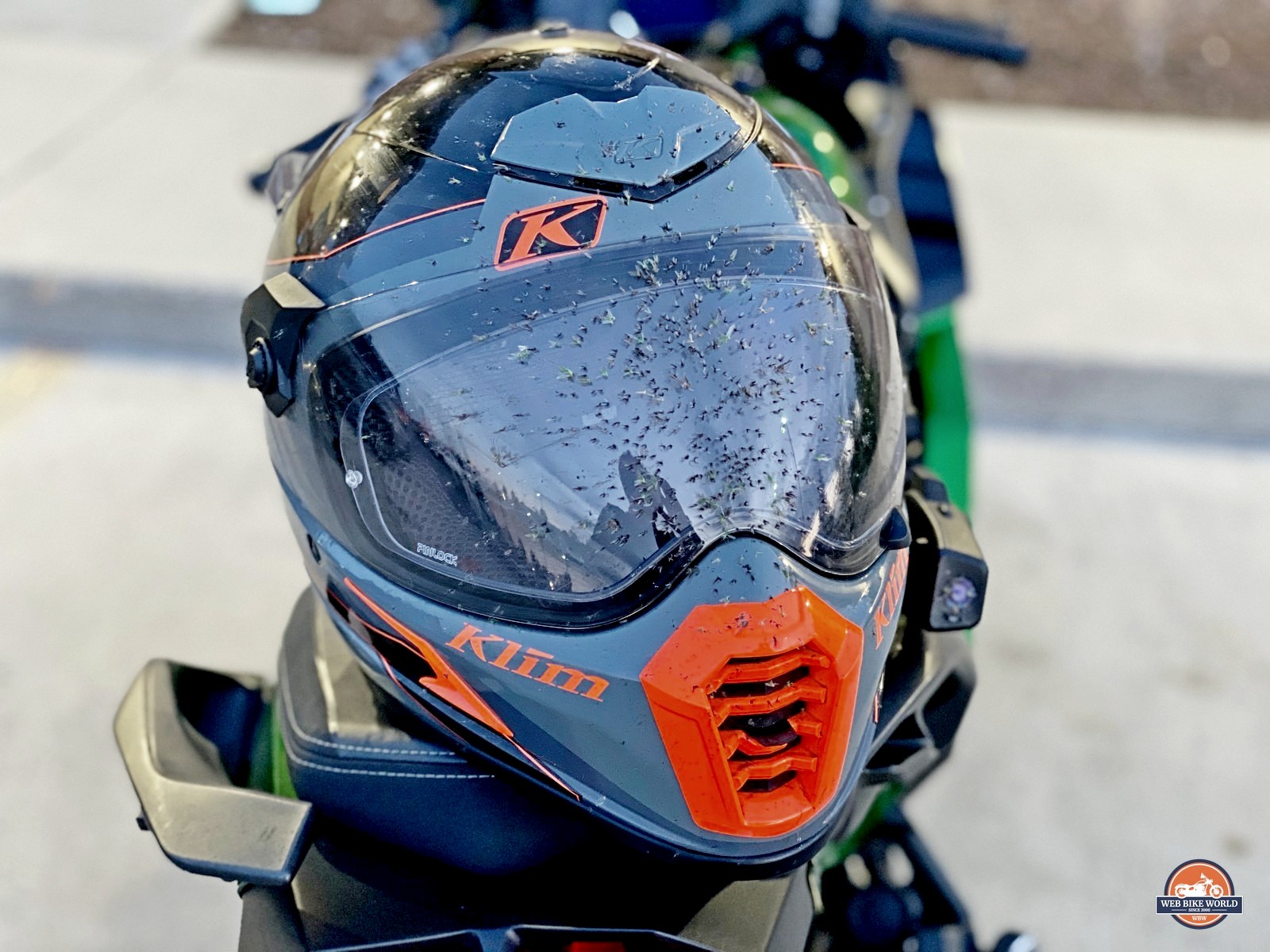
The Visor Detent Mechanism
My favorite thing about the XT’s visor is the tiny metal ball and spring mechanism that controls where the visor can be held spanning 8 possible detent positions. Most helmets make deafeningly loud clunks, pops, or thuds as the visor moves through its range of travel which irritates me.
In contrast, the spring-loaded steel ball in the XT9000 baseplate ticks quietly (kind of like the second-hand does on an analog Swiss watch) as it glides through the successive ladder of grooves on the inside of the visor. This brilliant assembly is not only soothingly quiet as I open or close the visor but silky smooth too.
The only visor I’ve used that’s quieter and smoother is my favorite one found on the Arai XD-4.
De-Fogging Position
This visor doesn’t mechanically lock when fully lowered but I haven’t had it pop open even when riding at higher speeds.
I’m happy to report that the visor can sit and hold itself barely cracked open to allow extra airflow to enter if the wearer wants more or just to clear away any mist/fog that might accumulate.
Visor Quick Release Mechanism
Removing some visors from the helmet for cleaning can be a real pain! Not so with the XT9000.
I’m a fan of the quick-release system Scorpion has on it which is nearly identical to the one on the Shark Spartan GT.
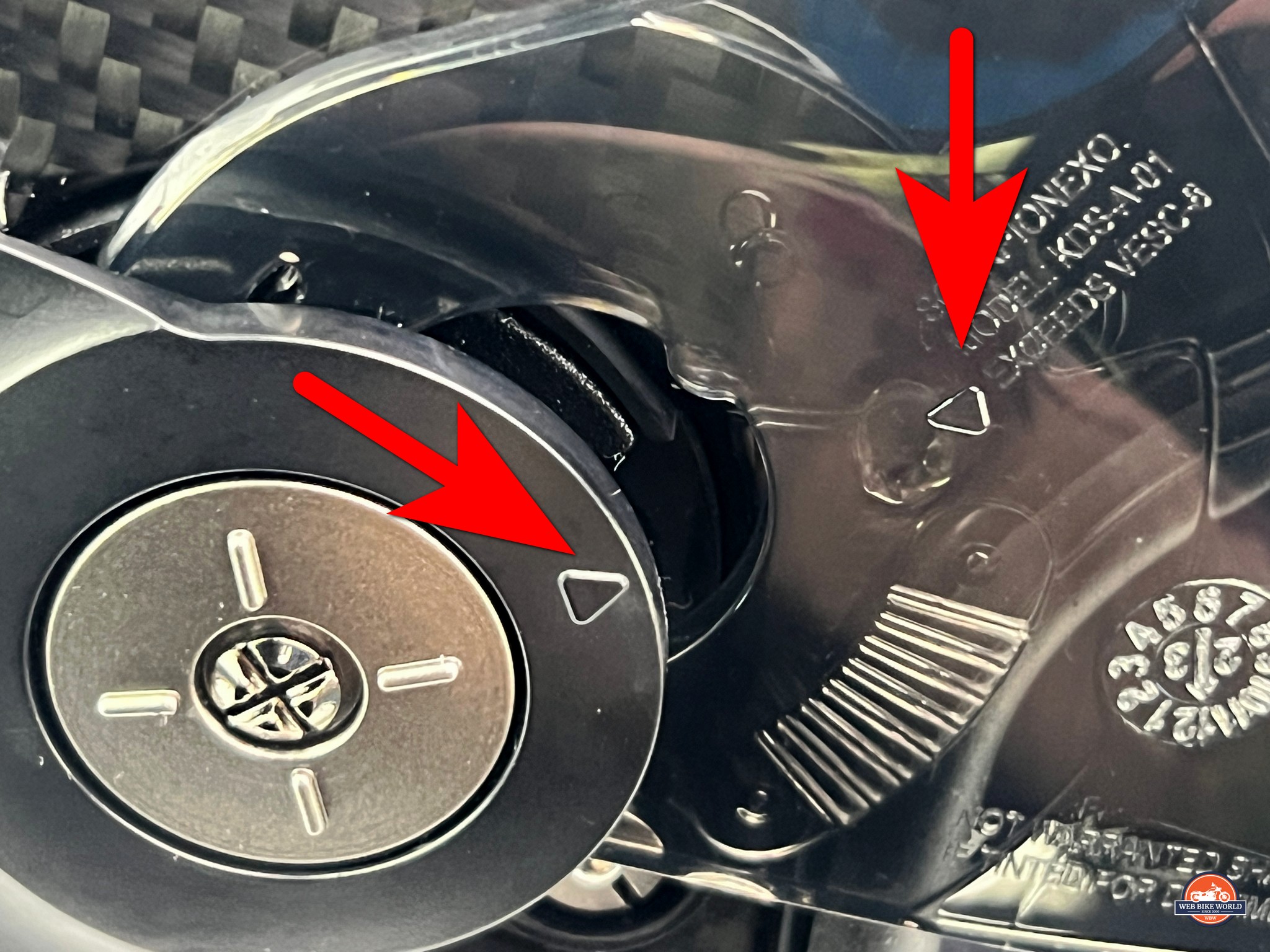
All you have to do is open the visor enough to align the triangle on the baseplate with the one on the visor and then pull straight outwards. Reinstallation is the reverse and it couldn’t be easier.
My pro tip to share on reinstalling the visor is to wear some nitrile gloves in order to avoid getting fingerprints all over your freshly cleaned visor.
Scorpion EXO XT9000 Ventilation
Adventure riders need better ventilation than street riders because of the slow speed riding done on more technical trails.
Scorpion says this XT9000 is for serious off-road riding and so I expected to experience above-average amounts of cooling airflow from this helmet during testing.
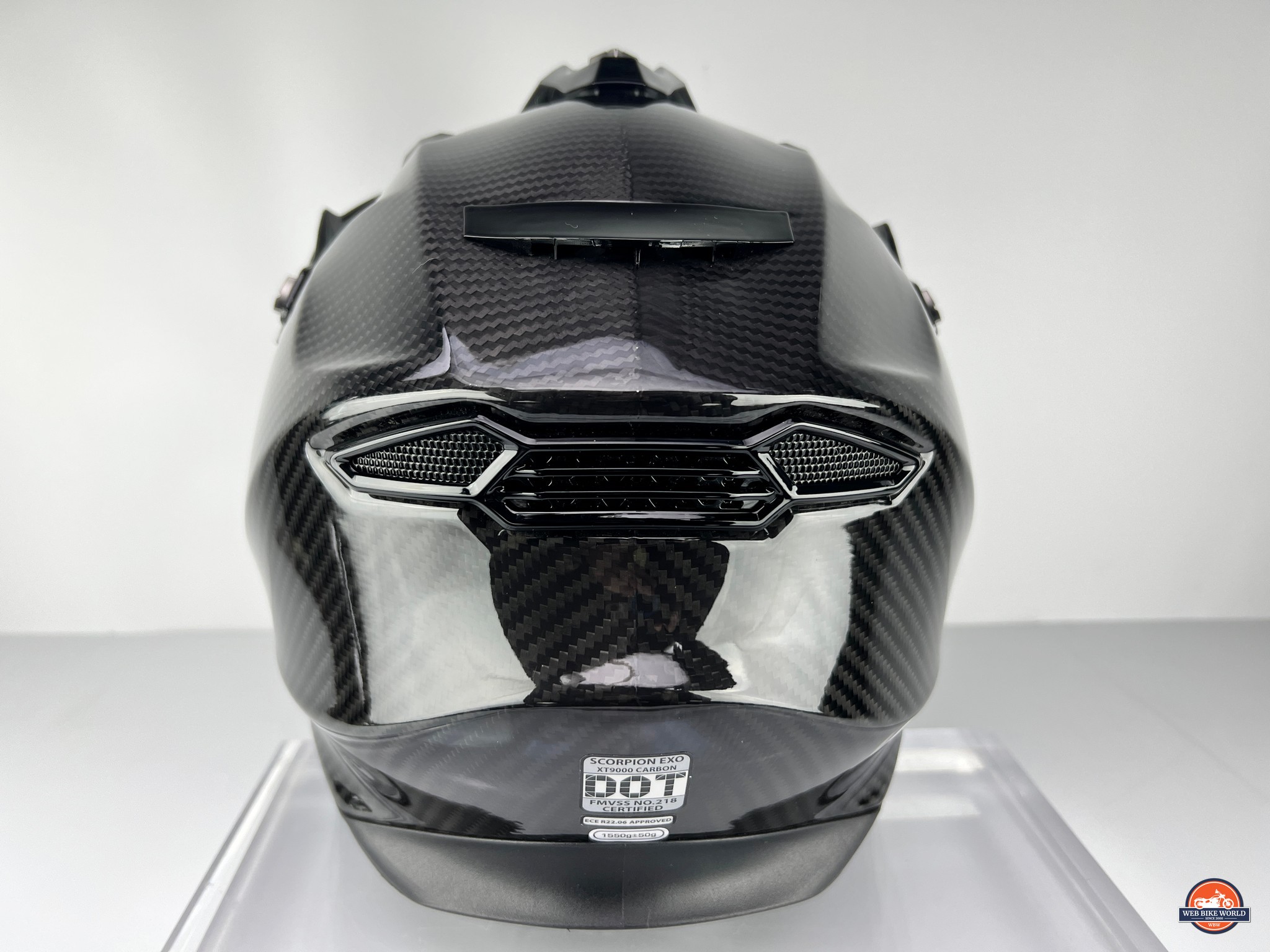
The Upper Vents
The two intake vents located on the front of the XT9000 do a good job of cooling the top of my head while riding thanks to the four exhaust vents located at the rear of the helmet.
Air is channeled through the comfort liner via several grooves in the EPS foam liner to evict perspiration and heat (above).
The sliding switches for the two top vents are large enough to grab with my gloved fingers although the rather tall sun peak does tend to get in the way. Riding with the peak removed makes moving these front sliders a breeze.
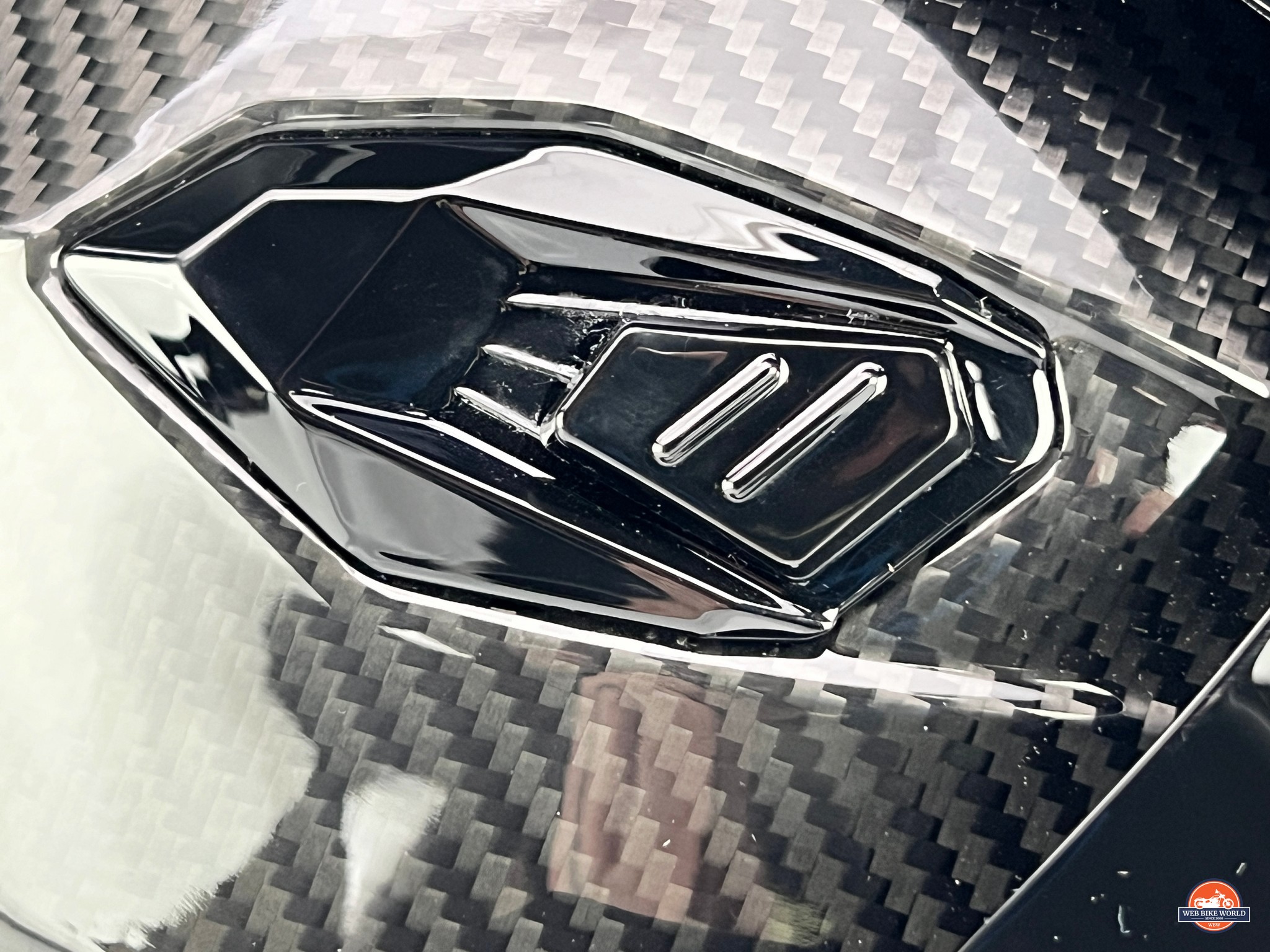
The Chin Bar Vent
The front vent on the chin bar leaves me wanting more air at all times even though there is always a small amount steadily entering the helmet from that area to help prevent visor fogging.
There’s an exterior vent switch along with a second switch on the inside of the chin bar used to control airflow into the wearer’s nose and mouth area. I can’t understand the need to have a difficult-to-reach interior switch instead of relying solely on the exterior one, but that’s how Scorpion went with the XT.
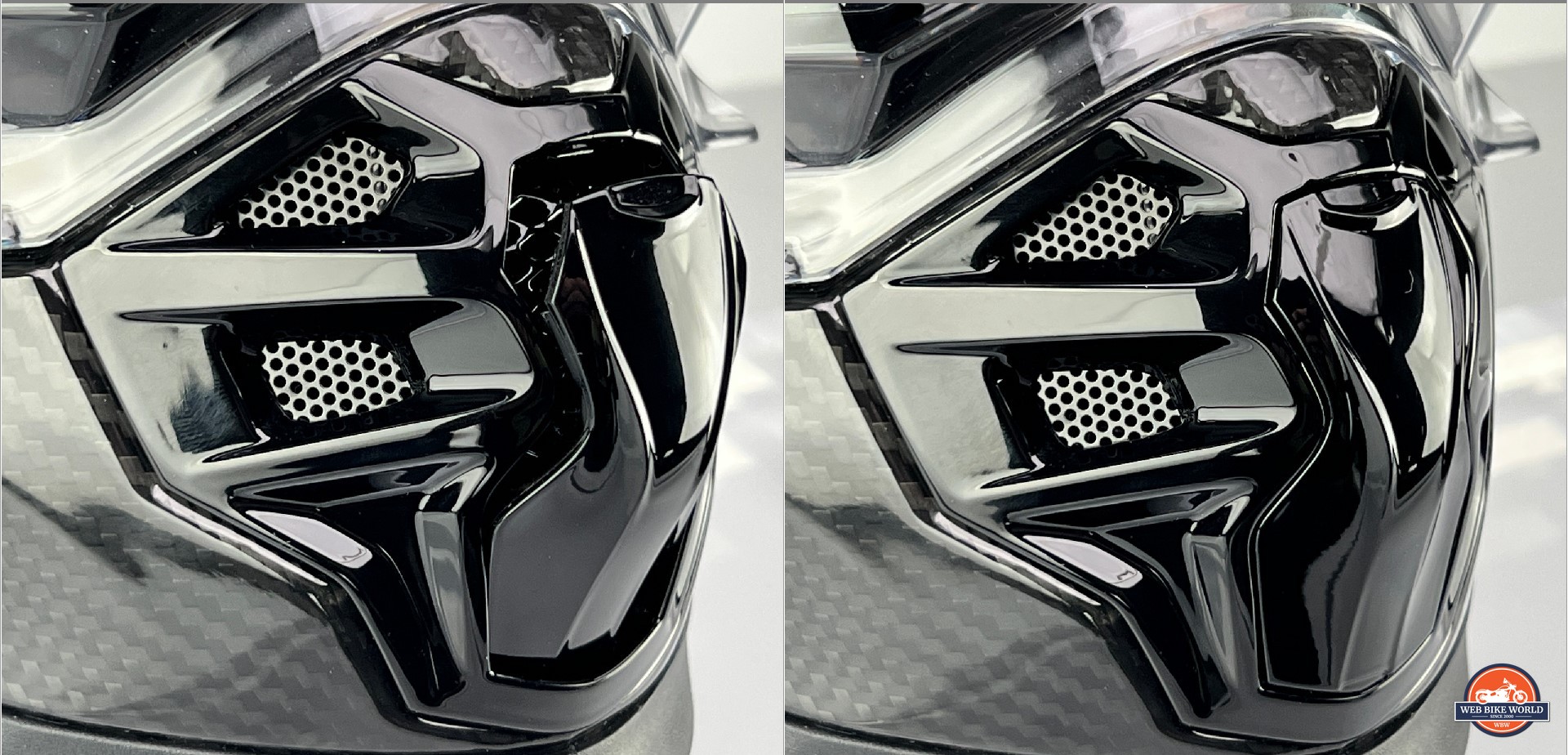
The exterior vent switch is a pivoting style that pops open at the top to increase the amount of cooling airflow when the lower part is pressed inwards. I experimented riding with different combinations of these two switches closed and opened but the airflow didn’t increase much at all and left me wanting more.
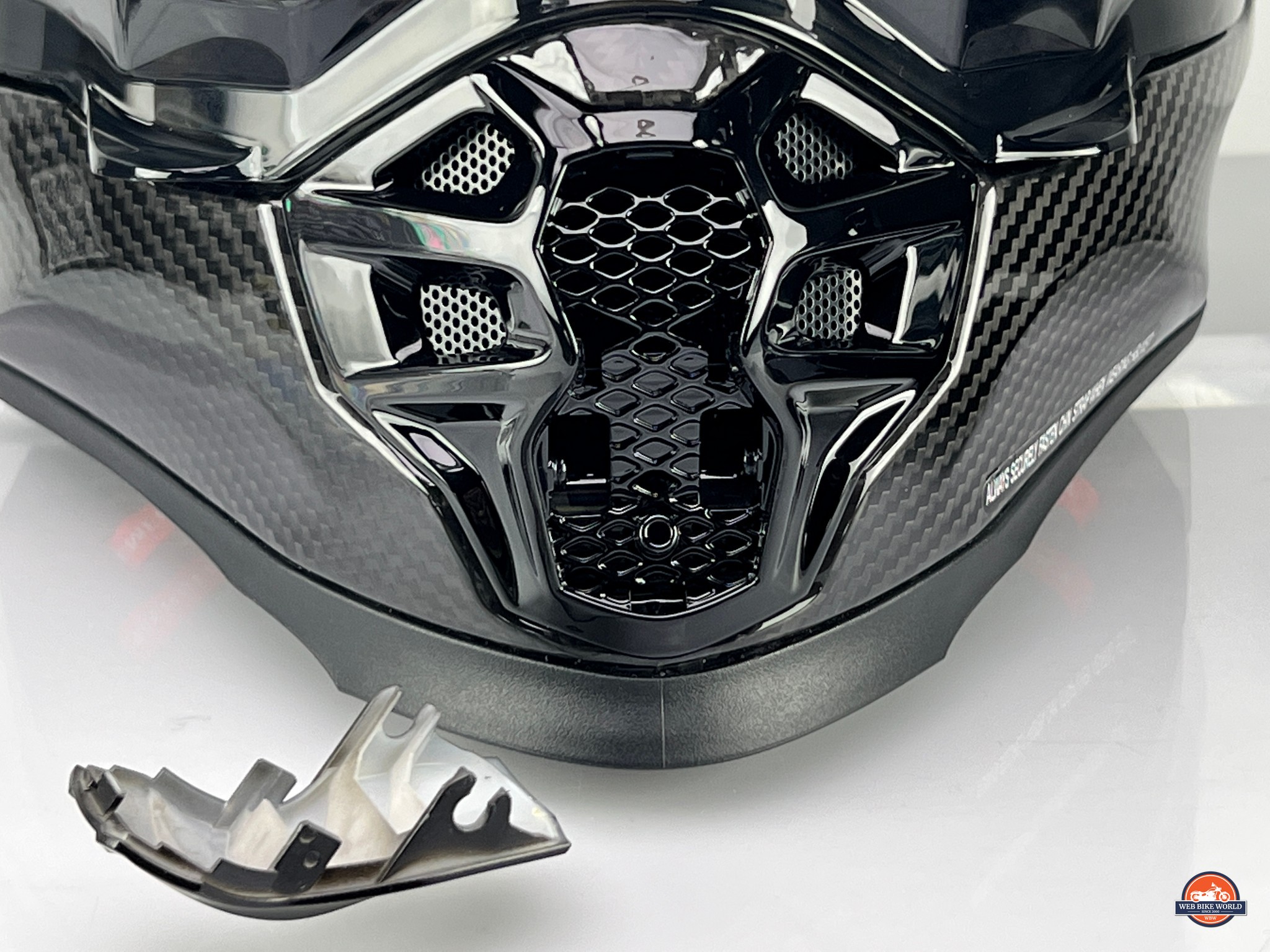
The exterior chin bar vent switch is more accurately described as a cover since it pops straight off if you pull outwards on it.
After removing it I found myself looking at what appeared to be a now much larger intake vent. I was certain that with the cover off I would be satisfied with the amount of incoming air, but that wasn’t the case. The airflow only increased a tiny bit and definitely not enough to keep my face cool during slow off-road riding.
Action Camera Mount
As I understand it, once the cover for the chin bar vent is removed it reveals a spot used for installing the action camera mounting plate that should come included with the helmet. As mentioned earlier I didn’t receive this accessory and couldn’t test it. That’s fine because never would I install anything in that spot because it would block off what little air enters through the chin bar vent already.
A Vent Too Small
My suspicion was that perhaps the foam used to keep bugs and dust out of the helmet in the chin bar vent might be plugged or obstructed, so I pulled down on the innards of the chin bar to access and inspect this filter.
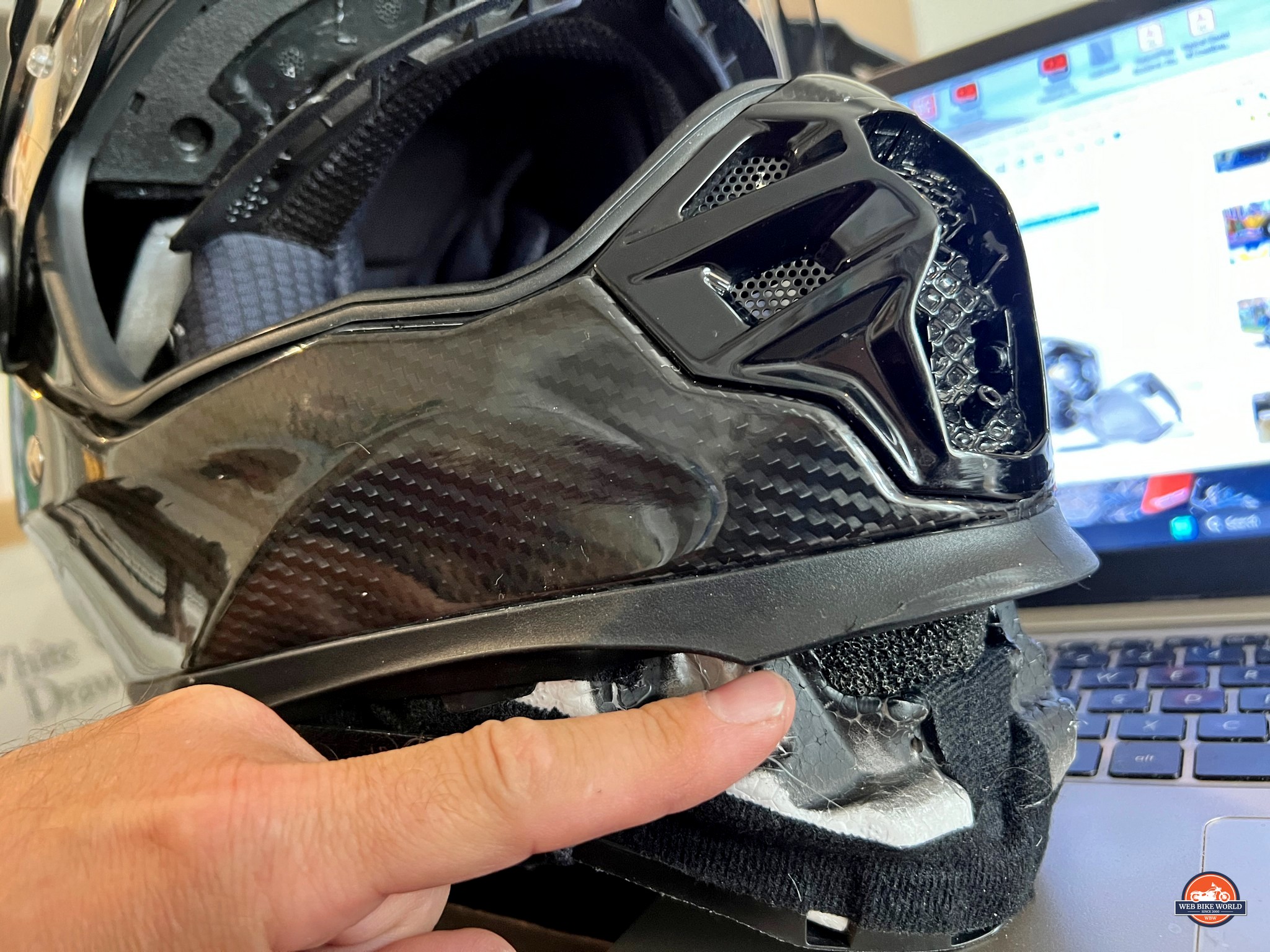
As you can see in the photo above the reason airflow is so limited coming into the helmet chin bar was the small orifice size, not an obstruction or anything else.
For serious adventure riding this opening should be at least 3 times larger than the one currently found in the XT9000, in my humble opinion.
The reason that the vent isn’t larger can be blamed on the Airfit system that runs below the vent taking up all the available space.
The Scorpion XT9000 Out On the Road
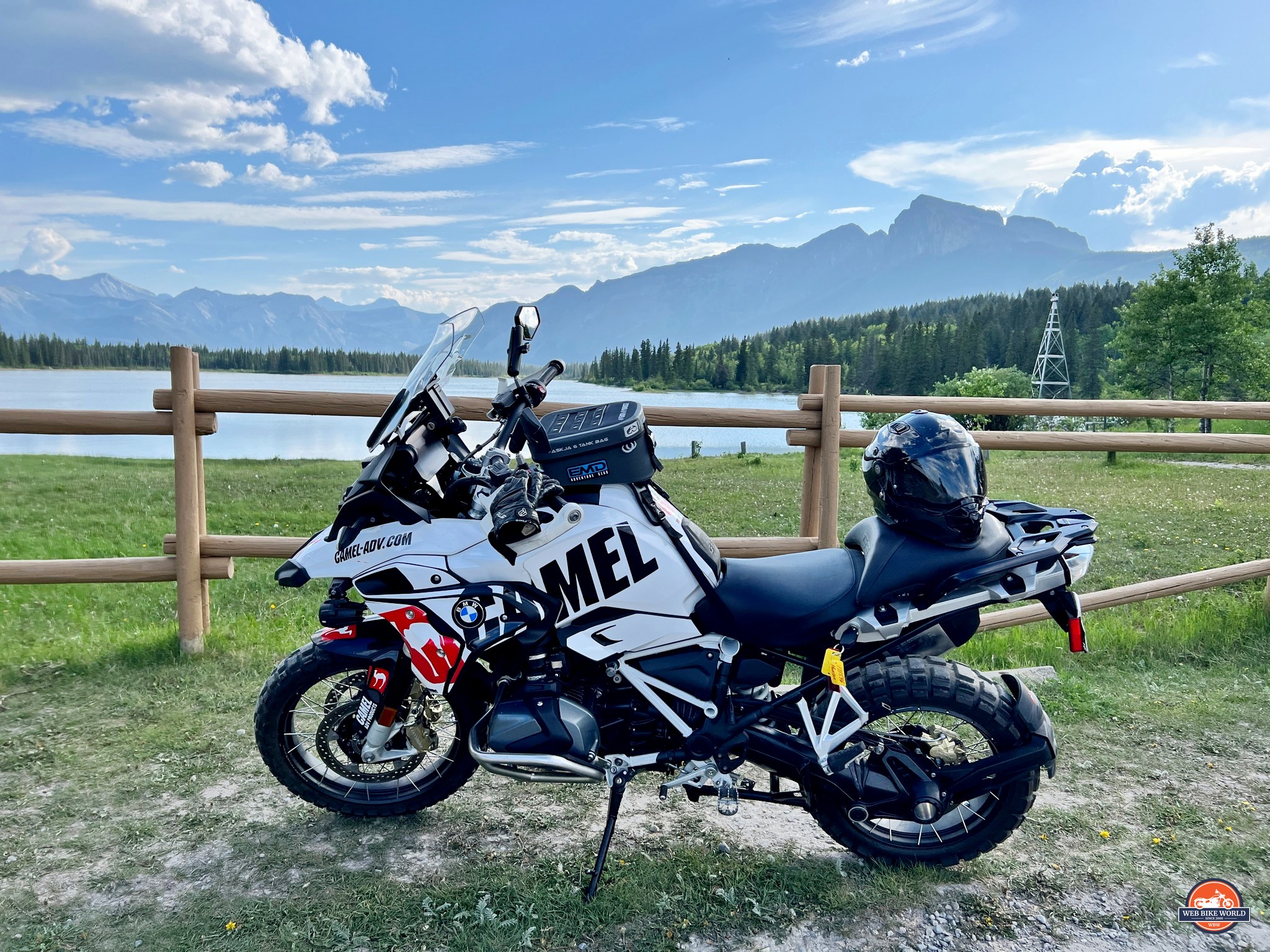


The XT9000 has some really nice design components to it, but how does it measure up when it’s out in the wild world of motorcycle riding?
It’s not too shabby overall, but it has some shortcomings.
Road Noise
Many riders wear earplugs these days and so I don’t place the importance on mitigating road noise that I used to while testing helmets. That’s good news for the XT9000 which is the loudest adventure helmet I’ve worn to date even considering how aerodynamically challenged adv helmets are to begin with.
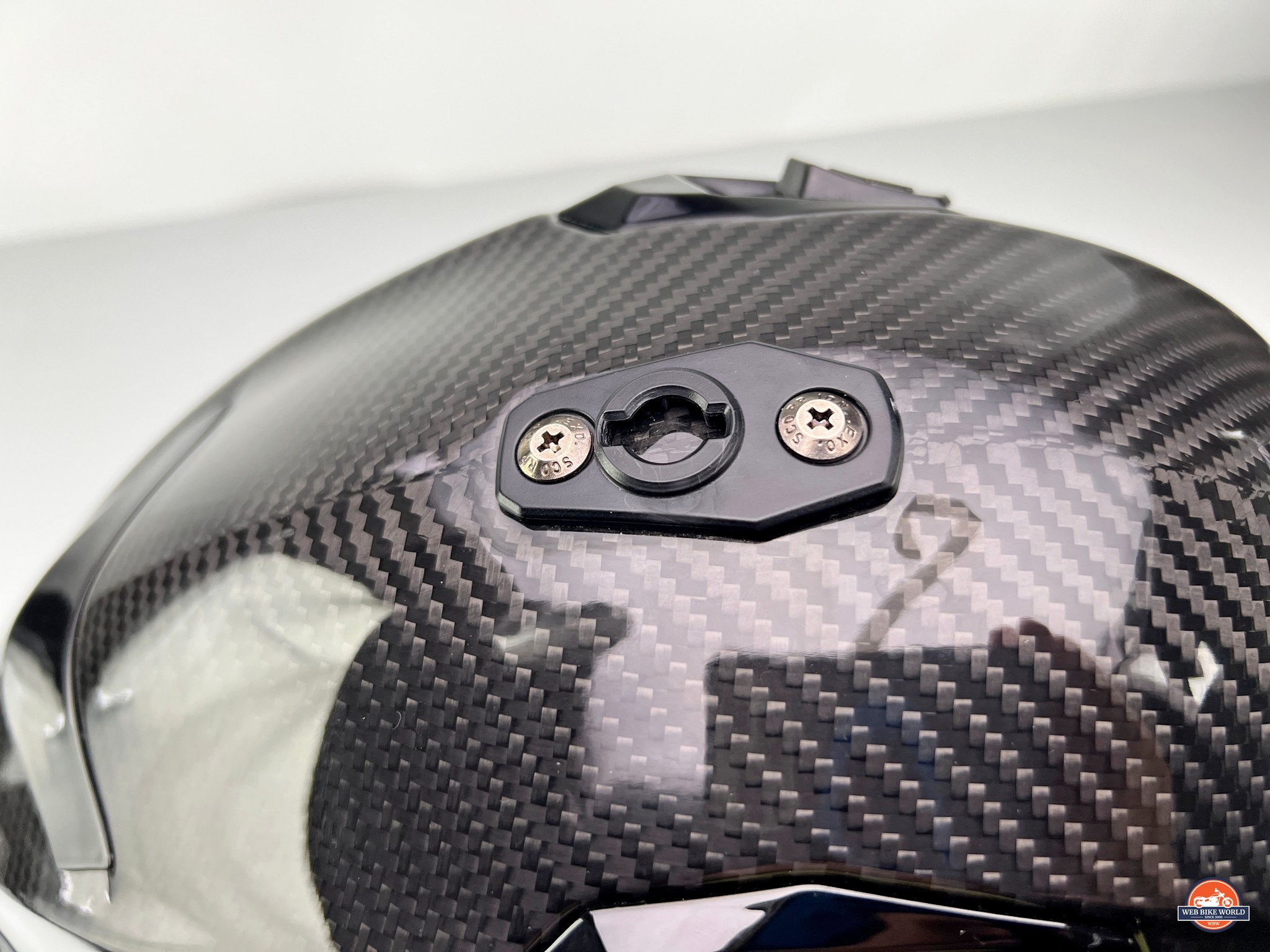


Removing the peak from the XT didn’t improve the road noise to my surprise. This symphony of turbulence is likely being caused by air rushing over the many sharp edges on the shell, visor baseplates, chin bar vents, and the peak mounting hardware.
Carbon fiber helmets are generally noisier than fiberglass and polycarbonate ones so the combination found on the XT9000 makes for a noisier helmet than average.
Rain Riding
It’s been unusually dry this year in Alberta and so I’ve only ridden in heavy rain once with the XT so far. Happily, the visor seal did its job and kept all moisture on the outside as intended.
Manufacturers seem to be able to get a better seal on new helmets these days unlike before when almost every helmet I tested would leak around the visor in rain riding.
Fogging Issues
The XT9000 visor fogs up easily if the Pinlock 120 lens isn’t installed in it. As mentioned before there’s no reason to hesitate using the Pinlock because Scorpion built the visor on the XT perfectly matched in shape to accept the Pinlock lens.
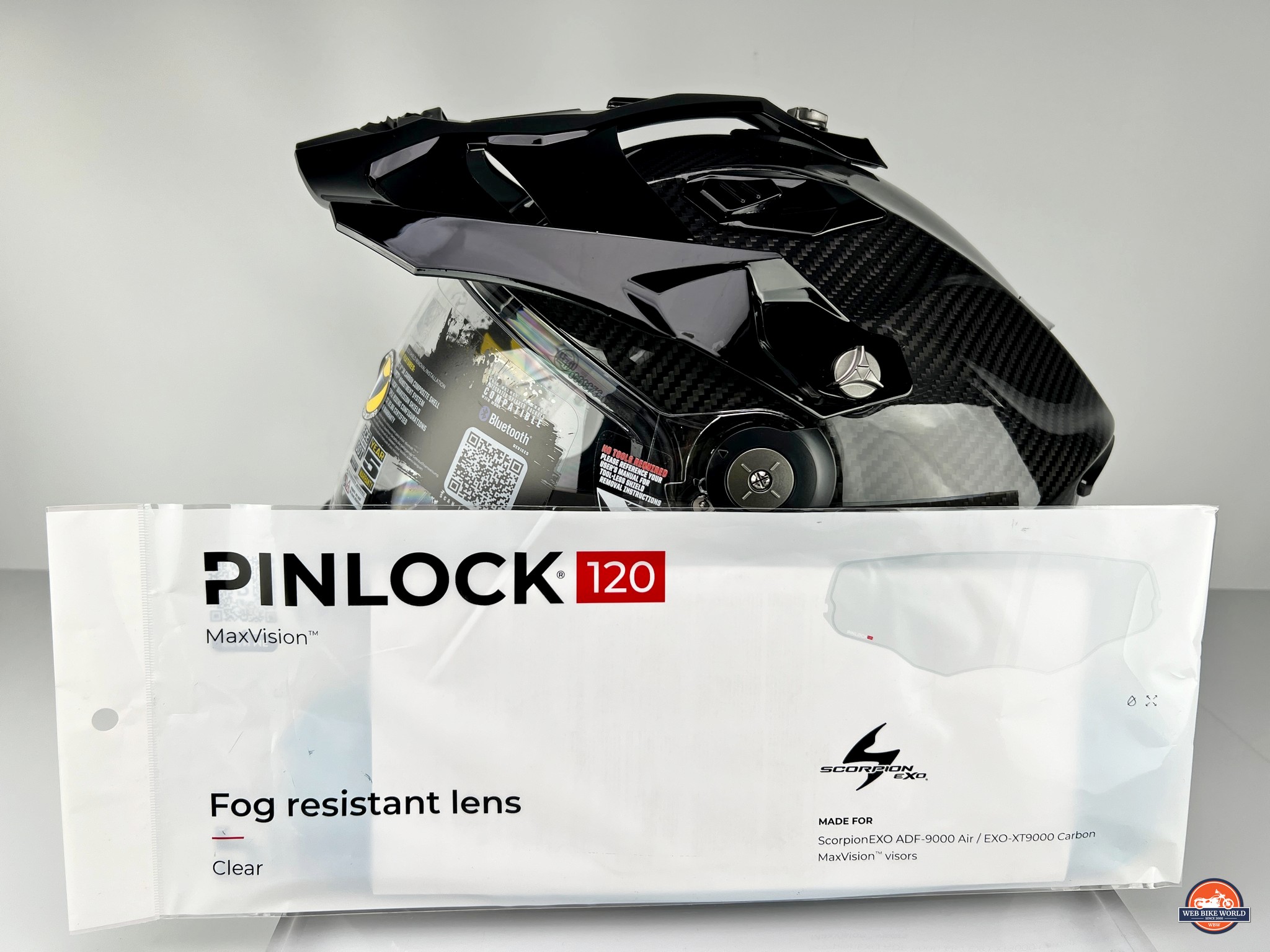


Buffeting, Lift & Pull
When riding at highway speeds while wearing the XT9000 I find crosswinds are a big problem when it comes to pulling and lifting.
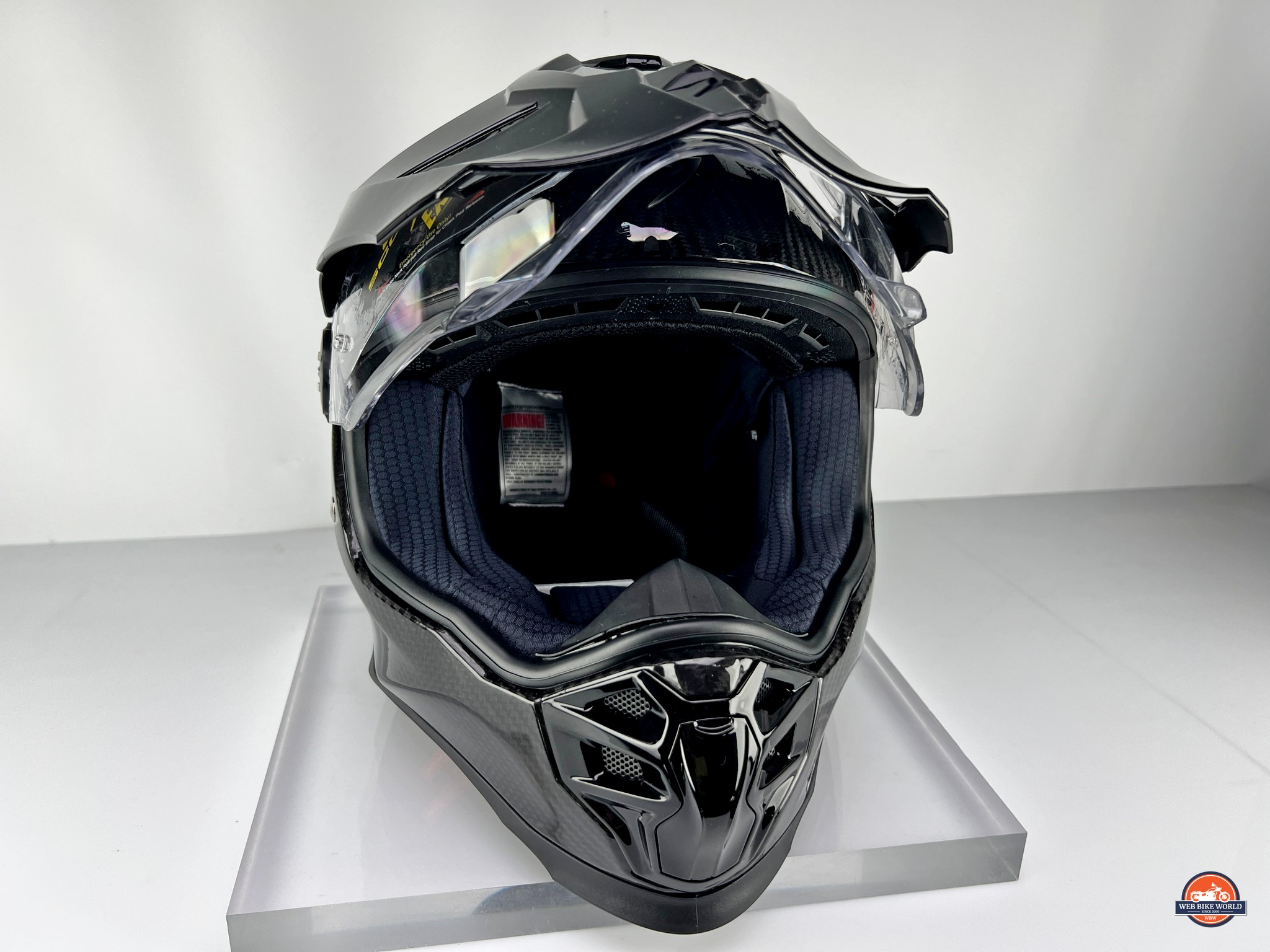


While cutting through oncoming airflow this helmet holds its own against buffeting, but crosswinds grab the peak and front of the helmet in ways that challenge my neck strength.
The XT9000 shell’s swooping shape suggests that it’s been wind tunnel tested like Shoei helmets are. If that’s the case then I would say someone’s aerodynamic calculations strategy hasn’t panned out. That isn’t to say the pulling is unbearable or necessarily a deal breaker, but it is more noticeable compared to my other adventure helmets. The perceived higher center of mass I already mentioned might be the root cause behind the higher degree of pulling.
Interestingly, riding without the peak installed on the XT9000 hasn’t improved its resistance to crosswinds to any great degree either.
Scorpion XT9000 Bluetooth Communicator Integration
The Cardo Packtalk Edge is currently my highest recommended in-helmet communication system and I tested it in the XT9000.
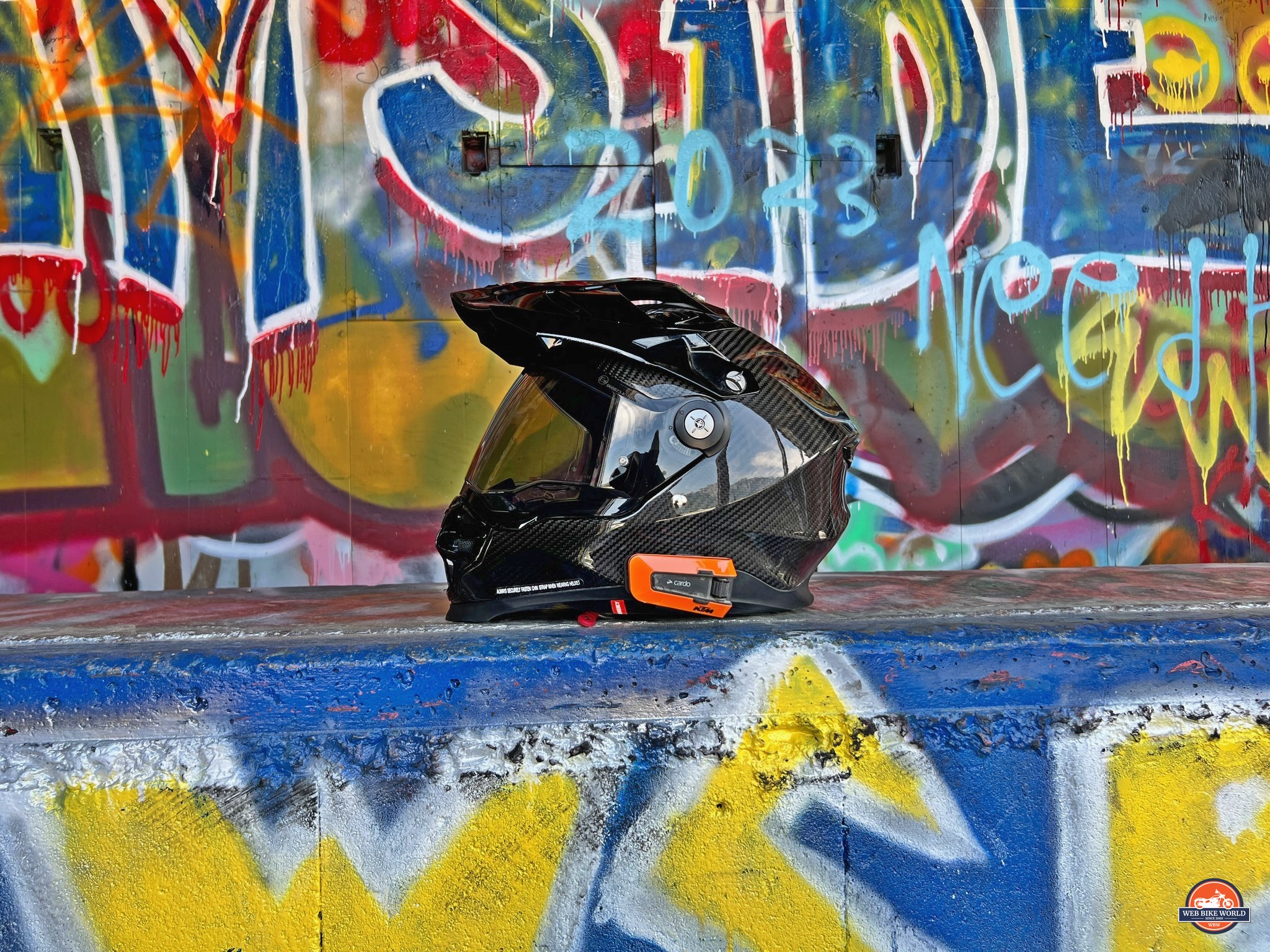


There were zero issues installing it in the helmet although I needed to cut a notch in the plastic fin that holds the left cheek pad in between the shell and liner. That surgery was necessary to provide a passage for the speaker and microphone wires to run from the Edge’s exterior mounted housing to the components that live inside the helmet.
Speaker Pockets
The 40mm JBL speakers on my Cardo Packtalk Edge easily fit into the speaker pockets of the XT9000 and the cheek pad liner has a fabric barrier to cover the speakers when installed.
The positioning of the speaker pockets is bang on for my ears but I made the mistake of leaving the foam covers on the speakers when I installed them. The foam covers when combined with the fabric barrier make it necessary to keep the volume setting at nearly full blast to hear music or phone calls clearly.
If I were to do it over again I would remove the foam speaker covers and try sticking the speakers directly to the cheek pad liners. This way they would touch my ears without any kind of barrier in the way of achieving the best sound quality.
Microphone Placement
The XT9000 has a great spot for mounting the microphone beside the inside chin bar vent switch. There’s no airflow in that spot to create microphone noise when I’m talking to another rider via intercom or on a phone call.
The Cardo voice control feature worked flawlessly as well further indicating a good microphone mounting point.
Scorpion XT9000 Hi-Visibility
Being conspicuous out on the road is an important way for motorcyclists to avoid collisions with other vehicles. I always hope to find reflective materials along with bright colors on helmets to help riders achieve this but often that strategy gets passed over by helmet designers.
The XT9000 Carbon Solid’s dark grey, carbon fiber exterior has nothing in the way of bright coloring on it but there is a Trailhead version available that has six high-viz options alternatively.
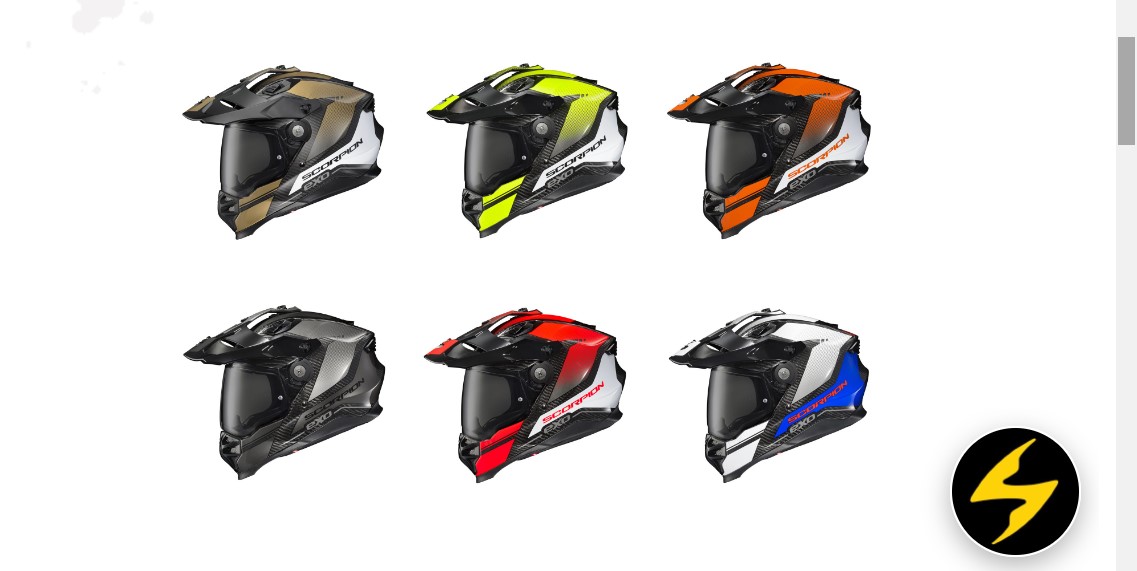


The Carbon Solid model does at least have a fairly large patch of light reflective material at the back of the neckroll to get you noticed at night, but a tall jacket collar could easily obscure it.
I realize many riders prioritize looking cool by wearing blacked-out helmets like the XT9000 Carbon Solid in lieu of a brightly colored decal package option as found on the XT9000 Trailhead version. That’s why It would be great to see Scorpion build in more reflective material on the XT9000 Carbon Solid in a subtle way with hidden stripes and decals that only appear when light shines on them.
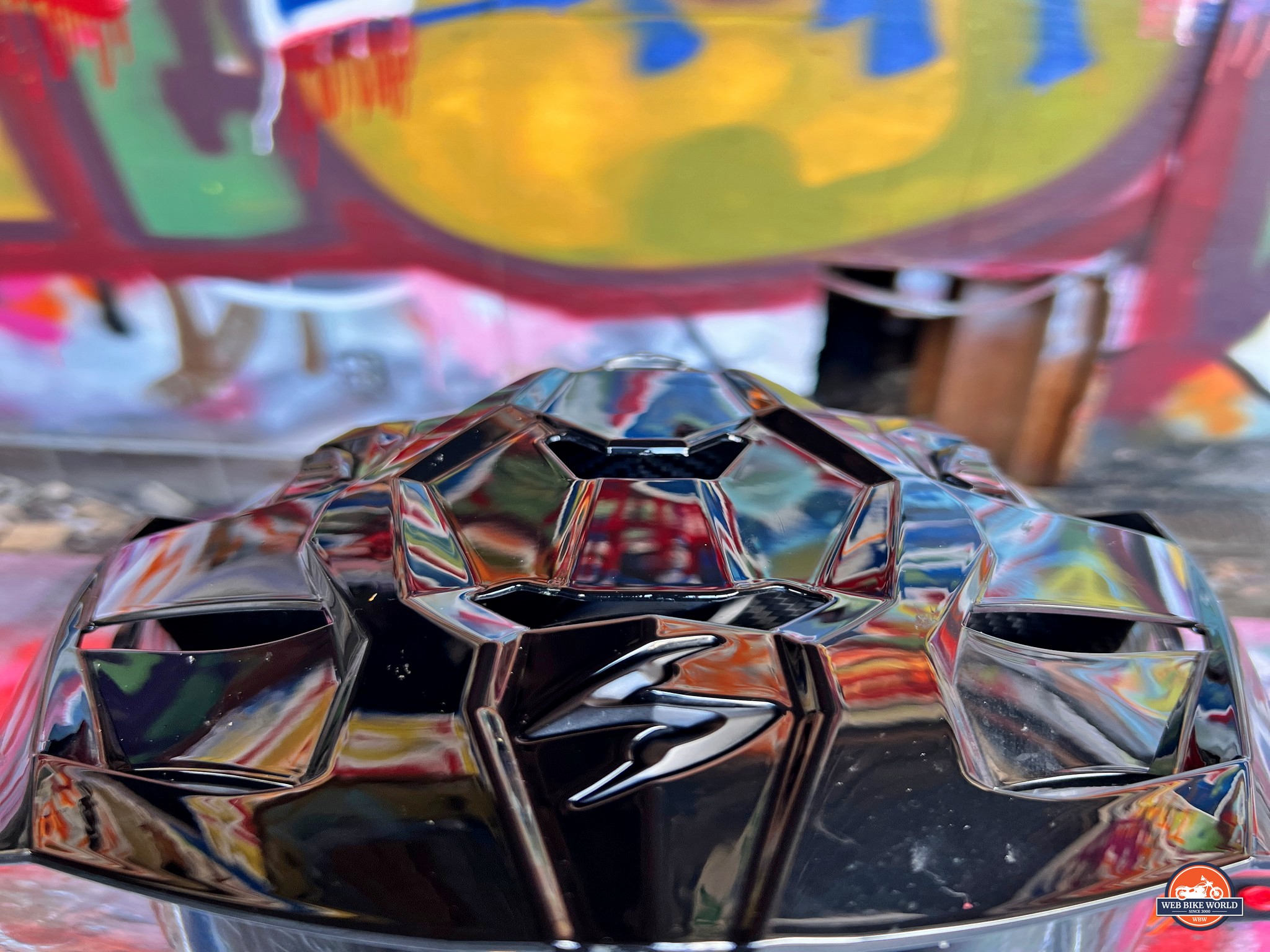


Final Verdict
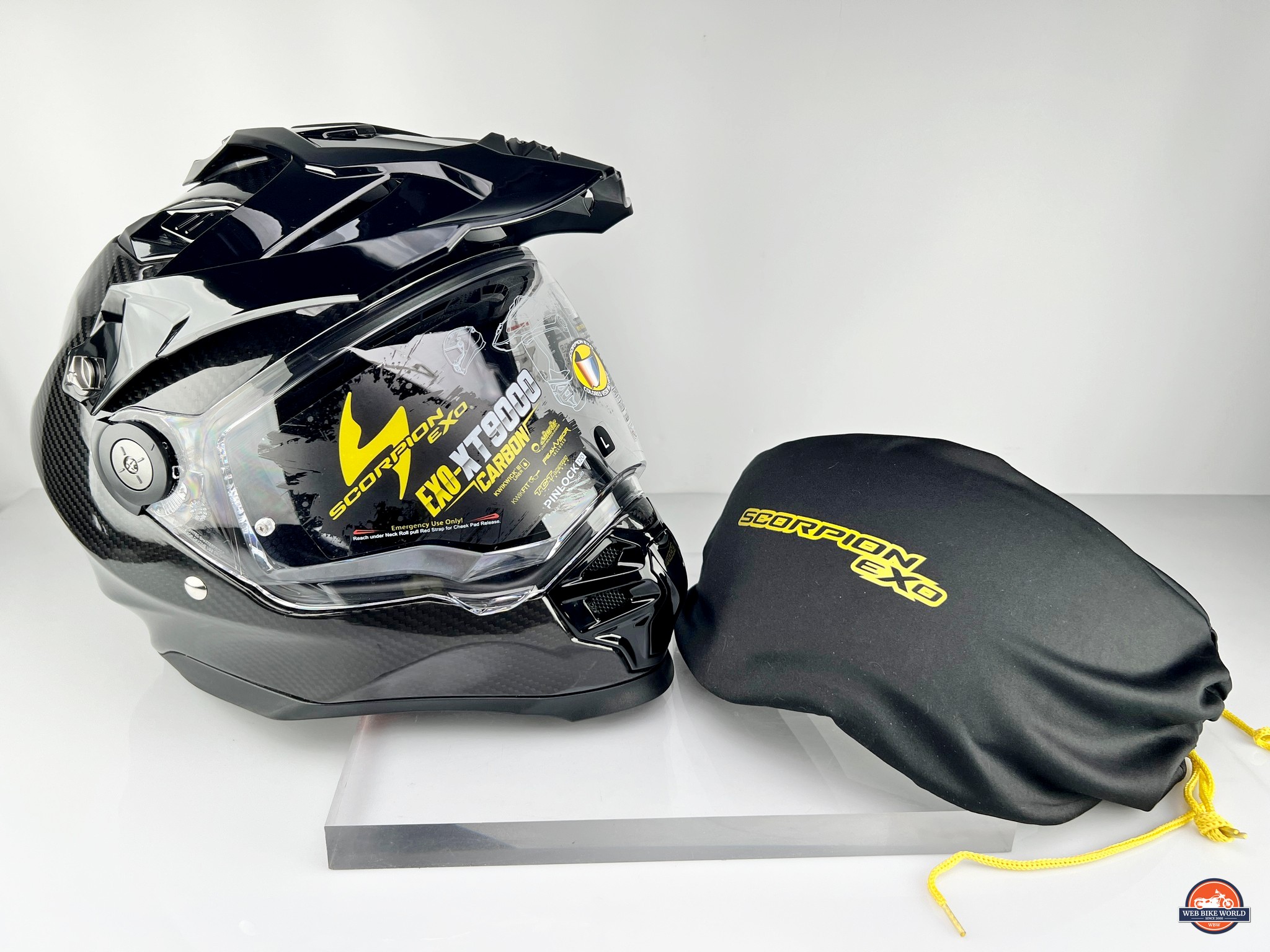


Scorpion has built a helmet that to my eye is similar in size, weight, and function to a couple of well-established adventure helmets: namely the Klim Krios and to a lesser extent the Klim Krios Pro. They’ve improved upon those designs with some great new features too.
Dollars & Sense
If I’m brutally honest about this Scorpion helmet I easily prefer wearing my much more expensive Klim Krios Pro and Arai XD-4. No one will be shocked to hear that.
Yes, it seems an unfair comparison but there are two areas where the XT9000 is better: affordability and how the Pinlock fits in the visor better than in the Krios Pro. The XD-4 visor isn’t Pinlock compatible at all, so there’s something for the XT9000 to trumpet about over my two favorite adventure helmets.
The Sobering Reality
The XD-4 and Krios Pro helmets both fit me better, weigh less (or have a lower center of mass), both have much better airflow, both aren’t as affected by crosswinds, both feel smaller/less bulky to wear, and in the case of the Arai: is more solidly built… but for twice the money these two helmets should be way better, right?!
It’s a closer race between the XT9000 and the Krios Pro when it comes to quality of build but the Klim is still my zero-hesitation preference — even at twice the cost. I’m the kind of guy who will save up for something I think suits my needs/wants better and that’s the case with the XT9000 vs these two premium competitors. True, many people may feel differently, and the average financial situation for riders is a huge factor I need to recognize… especially considering that we’re advised to replace our helmets every 5 years by manufacturers.
Unfortunately, I haven’t yet tested any other comparably priced adventure helmets to the XT9000 that I can share about in this review, but in looking at the specs I strongly suspect that I would prefer the XT9000 over the now obsolete Klim Krios.
Enter the AGV AX9 Siberia
I just received an AGV AX9 Siberia helmet to review which costs only a bit less than the XT9000. After I log some miles on the AGV I’ll be better able to make a good comparison between the two. You can bet I’ll mention the XT9000 in the AGV review. At first glance, I’d say the sun peak on the AGV is enormous and surely will grab crosswinds as much or more than the XT9000 does.
The XT9000 has impressed me enough to become my “go-to” baseline measuring stick to refer to in future adv helmet reviews and that’s saying a lot. Bravo Scorpion! This XT9000 is a great product many buyers will adore and they can be proud of that. With a couple of tweaks, this could be a top-level helmet too!
- Jim
Pros
- The visor quality/design is superb. Bravo!
- Value per dollar is unbeatable
- Ventilation is ok (but not top-level)
- The eyeport opening is massive
- The Airfit® liner inflation system can improve the fit
- Easy installation of Cardo or Sena devices
- ECE 22-06 certification in addition to DOT
- Carbon fiber shell is reasonably lightweight
- Replacement parts are inexpensive
- A good variety of colorways (9) are available
- Convertible design to suit street or aggressive off-road riding
Cons
- Prone to crosswinds grabbing the peak and helmet
- Feels big and bulky to wear
- Loud at highway speeds even with the peak removed
- Chinstrap snap for securing excess length is difficult to engage with gloves on
- Only one small reflective decal at the back of the helmet
Specs
- Manufacturer: Kido Sports
- Price when tested: $499 US
- Made in: China
- Sizes: XS to XXXL
- Colors: 9 options
- Safety Designations: ECE 22.06, and DOT FMVSS 218
- Review Date: June 2023


